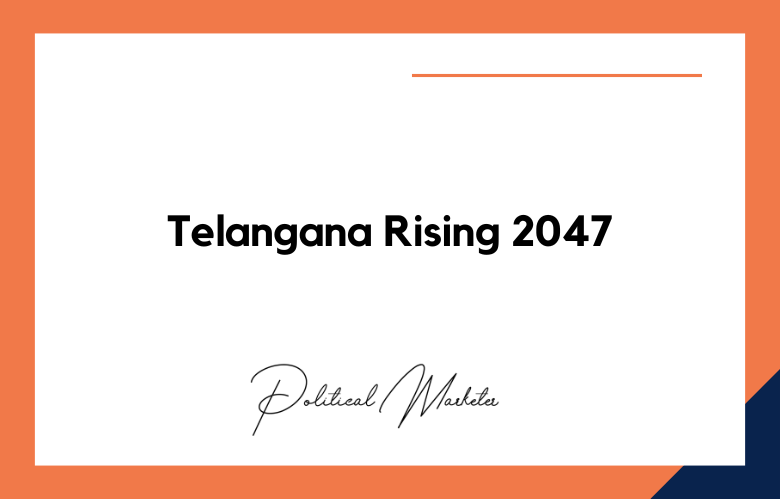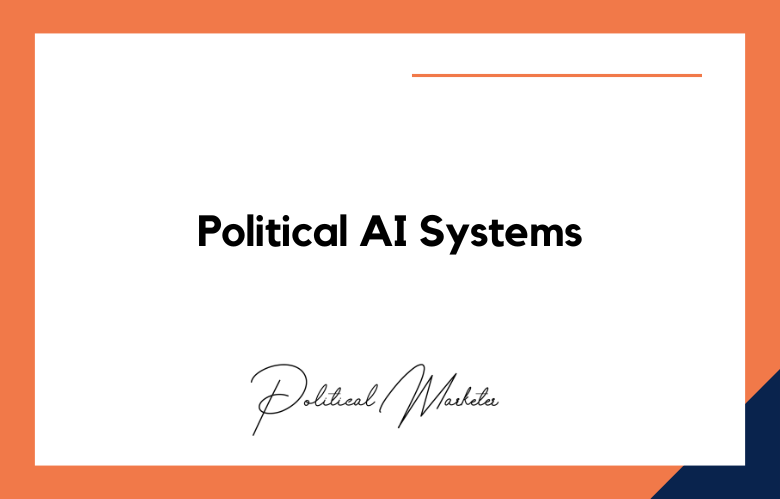Telangana Rising 2047 represents one of India’s most ambitious long-term transformation blueprints, integrating economic acceleration, human development, innovation leadership, and sustainability into a unified vision. Anchored in a rapidly growing GSDP of ₹16.12 trillion and a robust 10 percent annual growth rate, the state is positioning itself to evolve into a multi-trillion-dollar economy by 2047.
The Vision Acceleration model emphasizes balanced growth through a combination of high-value services, world-class infrastructure, and innovation-driven development. Telangana’s distinctive strength lies in its fiscal autonomy, with 88 percent of its tax revenue generated internally, enabling strategic investment in flagship projects that align with long-term economic objectives.
This framework is supported by targeted reforms, inclusive development initiatives, and large-scale urban transformation programs that, together, lay the foundation for achieving a ₹3 trillion economy over the coming decades.
At the heart of the vision is a fundamental commitment to raising the state’s human development standards. Telangana recognizes that economic success must be underpinned by substantial social progress, particularly in literacy, healthcare, and skill development. While overall literacy has improved to nearly 73 percent, significant gaps remain, especially among rural women, whose literacy rate stands at just 53.7 percent.
Vision 2047 addresses these disparities through mission-mode campaigns such as Women Farmer Youth Clubs, Skills Universities, AI-based learning tools, healthcare expansions, and community-led literacy programs. Health reforms such as expanding Aarogyasri to ₹10 lakh per family, strengthening institutional deliveries, and improving maternal care demonstrate the state’s focus on human capital as a critical pillar of long-term productivity and inclusive prosperity.
Infrastructure and spatial transformation form the backbone of Telangana’s 2047 trajectory. Landmark initiatives such as Bharat Future City, a 30,000-acre net-zero economic zone, and AI City, a 200-acre global innovation hub, represent a new wave of planned urban development integrating sustainability, mobility, technology, and climate resilience.
Metro Phase II B expansion, the Musi Riverfront rejuvenation, new national highways connecting ports, and upgraded logistics corridors collectively position the state as a world-class investment destination.
The Musi project, in particular, addresses a critical urban challenge by establishing a permanent flood management strategy that interlinks lakes, drains, and catchment zones while improving public spaces and environmental quality.
These infrastructure upgrades not only enhance Hyderabad’s competitiveness but also distribute growth toward tier 2 and tier 3 districts through industrial corridors, dry ports, and rural connectivity networks.
Agriculture and rural prosperity remain central to the state’s inclusive growth plan. With nearly 43 percent of the workforce dependent on agriculture, Telangana Rising 2047 focuses on modernizing farm practices, expanding irrigation facilities, restoring tanks, strengthening FPOs, and promoting digital agriculture through eNAM and AI-driven advisory systems.
The Women Farmer Youth Club model stands out as a transformational social innovation, integrating income enhancement, risk mitigation, digital literacy, and resource access into a unified rural development strategy. This inclusive framework links agriculture to the urban growth story through food-processing clusters in Future City, ensuring that rural communities benefit from the broader economic expansion.
Sustainability and climate leadership are defining themes of Vision 2047.
A commitment to 33 percent forest cover by 2047 and the establishment of large forest zones within Future City reflect a deep integration of ecological resilience into urban planning. Climate risk assessments, circular economy initiatives, EV ecosystem expansion, and waste-to-energy solutions strengthen the state’s preparedness for heatwaves, droughts, and urban flooding.
This dual approach of economic expansion and environmental stewardship enhances global investor confidence and supports the state’s Net Zero Telangana ambition.
Innovation, AI, research, and technology form the intellectual engine of Telangana’s future. AI City and the Telangana AI Mission, developed with NASSCOM, J-PAL, and global academia, aim to position the state among the world’s top 20 AI hubs by 2035.
The state’s innovation ecosystem includes more than 6,500 startups, globally recognized incubators such as T-Hub and WE Hub, rising R&D expenditure, and strong university-industry partnerships.
Emerging sectors such as quantum computing, climate tech, biotech, EVs, and aerospace manufacturing are strengthened by policy support, talent development programs, and a vibrant entrepreneurial culture. Telangana’s competitive advantage lies in its synergy of infrastructure, innovation, regulatory efficiency, and human capital readiness.
Governance excellence remains a defining pillar of Telangana Rising 2047. Digital governance platforms such as MeeSeva, real-time dashboards, transparent budget execution, grievance redressal analytics, AI-powered public service delivery, and economic diplomacy through embassies collectively reinforce the state’s leadership in innovative governance.
With strong partnerships across global consulting firms, industry bodies, and private-sector institutions, Telangana has created an ecosystem of credibility, efficiency, and trust. The government’s proactive outreach to global CEOs, combined with showcase-driven engagement strategies such as the Telangana Global Summit 2025, signals a new style of governance where policy, investment, and innovation converge seamlessly.
Telangana Rising 2047 is not just a development roadmap; it is a comprehensive transformation intelligence framework. It integrates economic expansion, spatial planning, social empowerment, climate resilience, digital governance, and innovation-driven ecosystems into one unified pathway.
By aligning infrastructure, sustainability, human development, and global competitiveness, Telangana is positioning itself as a future-ready, trillion-dollar-capable economic powerhouse. If executed with sustained focus, Vision 2047 has the potential to make Telangana one of India’s top-performing states across economic, social, and technological indicators, setting new standards for inclusive, sustainable, and innovation-led growth.
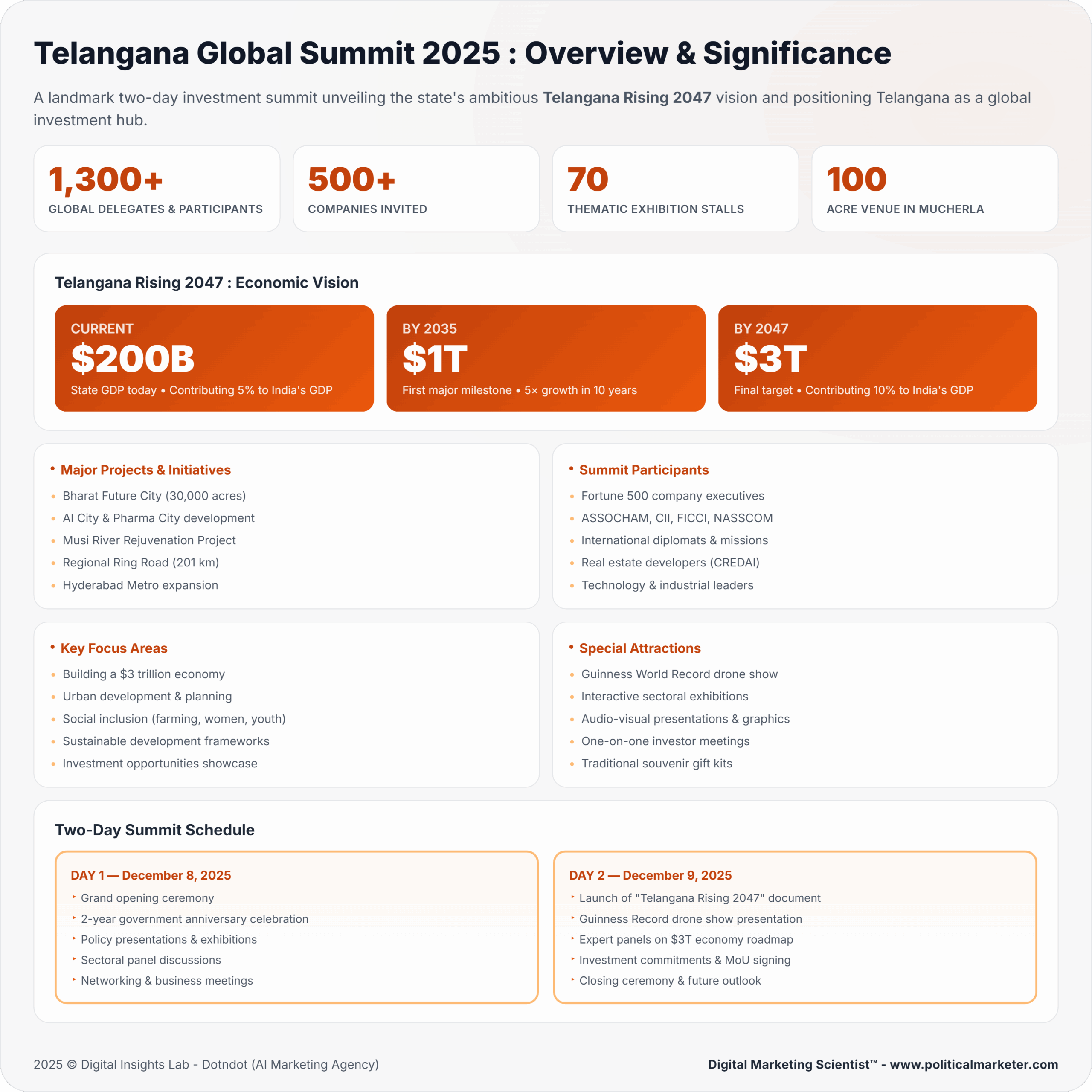
Core Vision Metrics
Telangana’s core vision metrics set the baseline for its long-term transformation under Telangana Rising 2047. The state’s economy stands at ₹16.12 trillion, with a steady 10 percent annual growth rate, strengthening its capacity to fund development without external dependence.
The year 2047 serves as the target point for the state’s multi-phase reform agenda, supported by the goal of building a ₹300 trillion economy. These metrics together create a clear starting position, a measurable path, and an ambitious economic destination that guide the state’s strategy for sustained growth, innovation, and social progress.
Current GSDP (FY 2024–25)
Telangana’s current Gross State Domestic Product stands at ₹16.12 trillion. This figure signals the scale of economic activity produced within the state during the financial year. It reflects sustained expansion across services, industry, and agriculture. You can see this number as the foundation for every long-term target set under Telangana Rising 2047.
It confirms that the state has moved into a high-growth tier in India and now operates with an economic base strong enough to support a multi-decade transformation plan.
GSDP Growth Rate (Year on Year)
The state recorded a 10 percent annual growth rate. This level of growth strengthens fiscal capacity and allows the government to invest in large public programs without depending on external support. A 10 percent growth rate also indicates strong performance when compared with other central states, especially at a time when global markets face uncertainty.
It shows that Telangana is steadily expanding its productive sectors. It also creates a stable environment for private investors seeking predictable growth.
Vision Target Year: 2047
The year 2047 serves as the horizon for the state’s long-term economic and social goals. This date marks the end of a structured plan spanning several phases. Each phase contains economic, social, environmental, and governance milestones.
By giving the vision a clear end year, the state sets a predictable timeline that departments and private partners can follow. You can track progress from this year backward to evaluate whether current actions support long-range objectives.
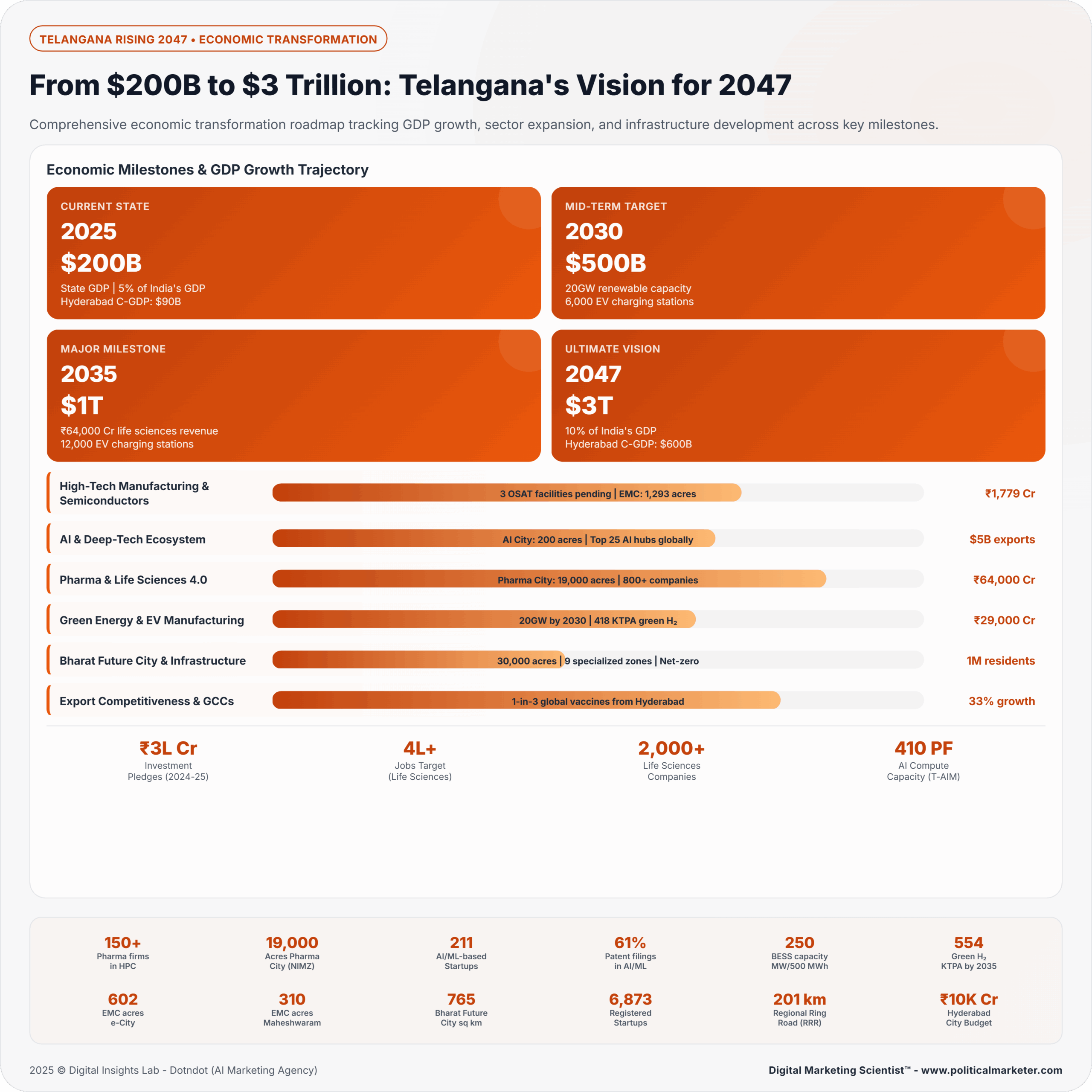
3T Vision Economy Target: ₹300 Trillion
Telangana aims to grow into a ₹300 trillion economy by 2047. This target sets a clear direction for policy, planning, and investment. It requires sustained growth, technological adoption, sector diversification, and strong human development outcomes.
The target also requires expansion across districts that currently contribute less to the overall economy. The ₹300 trillion goal compels the state to strengthen innovation ecosystems, industrial corridors, agricultural modernization systems, and skills development programs. It creates a unified economic purpose that guides departments and private partners toward shared outcomes.
How These Metrics Connect to Vision Acceleration
These four indicators work together to define the starting position and long-term trajectory of Telangana Rising 2047. The current GSDP shows the economic base. The annual growth rate shows the pace of expansion. The 2047 timeline provides structure. The ₹300 trillion target sets the ambition.
Together, they create a measurable roadmap that connects day-to-day governance with long-term transformation. You can use these metrics to assess whether policies, infrastructure projects, digital initiatives, and social programs support the required economic momentum.
Each metric also highlights areas where the state needs improvement, such as district-level balance, workforce readiness, sector diversification, and sustainable energy adoption.
Strategic Importance of These Metrics
These indicators allow the government, investors, and citizens to understand the state’s economic direction. They help track whether current progress supports the target economy size. They also show areas where strategic acceleration is necessary.
For example, reaching a ₹300 trillion economy requires consistent double-digit growth, technological advancement, improved human development outcomes, and stronger regional participation. These metrics give you a clear picture of what the state needs to strengthen and how it plans to build economic strength over the next two decades.
Vision 2047 Framework
The Vision 2047 Framework sets the long-term structure for Telangana’s economic and social transformation. It brings together key pillars, including economic growth, human development, infrastructure expansion, rural prosperity, sustainability, innovation, and governance.
Each pillar supports the goal of building a stronger, more balanced state economy while improving the quality of life across districts. The framework provides a clear path from current performance to the targets set for 2047, ensuring that every major initiative contributes to a unified transformation plan.
Vision 2047 and 3T Economy Snapshot
Vision 2047 and the 3T Economy Snapshot outline Telangana’s long-term economic path and the scale of growth the state plans to achieve. The current economy stands at ₹16.12 trillion, with a 10 percent annual growth rate, providing a strong base for future expansion.
The 3T goal sets a clear direction for the state to achieve an economy of ₹300 trillion by 2047. This requires steady gains in services, industry, innovation, and district-level development. The snapshot shows how major projects, human development programs, digital governance, and sustainability measures all support the economic targets.
Together, these elements form a structured roadmap that connects present performance with the long-term ambitions of Telangana Rising 2047.
AI Generated Strategic Summary: Q4 2025
The strategic summary for Q4 2025 captures the most significant shifts that support Telangana Rising 2047. The quarter recorded strong global interest, with major companies and senior delegates confirming participation in the Global Summit 2025.
Future City expanded its development scale and strengthened its role as India’s largest economic zone. AI City advanced through new partnerships with global technology leaders and reinforced Telangana’s position in emerging research fields.
The state’s economy maintained a 10% growth rate and continued to rank among the fastest-growing in the country. Manufacturing and logistics also improved through upgraded corridors and stronger port connectivity, which support long-term goals under the 3T economy framework.
Top 5 Transformational Shifts in Telangana
Telangana recorded five major shifts this quarter that strengthen its progress toward Vision 2047. Global participation in the upcoming summit increased sharply, showing higher investor confidence. Future City expanded its scale and reinforced its position as the country’s largest economic zone.
AI City advanced through new partnerships and solidified the state’s growing role in advanced technology. The economy maintained strong growth with steady gains from the services sector. Manufacturing and logistics also improved through corridor upgrades and better port connectivity, which support long-term economic expansion.
Massive Global Participation
Telangana recorded a sharp rise in both domestic and international interest ahead of the Telangana Global Summit 2025. More than 500 leading companies have confirmed their participation in the December event. The state is also preparing to host 1,300 senior delegates who will visit Bharat Future City.
This level of engagement represents a three-hundred percent increase in investor interest compared with earlier events. You can see how this turnout strengthens confidence in the state’s development capabilities and signals that global companies are interested in reviewing large-scale projects on-site.
Future City Momentum Accelerates
Future City expanded its scale and strengthened its role as a core growth zone in the state’s long-term transformation plan. The infrastructure and logistics pipeline increased by forty percent during the quarter. The project added another 30,000 acres to its existing 30,000-acre development area.
This expansion positions it as India’s largest economic zone. The increased land availability, combined with ongoing infrastructure investments, supports the development of new industrial clusters, research districts, and technology-driven employment. You can see how this momentum helps the state advance toward its long-term economic targets.
AI and Innovation Growth Surges
AI City has advanced to become one of the fastest-growing technology hubs in the country. These collaborations strengthen research capacities in areas such as automation, applied machine learning, and data science.
Telangana set a clear target to rank among the top 20 AI hubs globally by 2035, and progress this quarter shows steady movement in that direction. You can see how this growth builds a stronger innovation system that supports talent development, high-value research, and industry expansion.
Strong Economic Outlook
The state’s economy reached ₹16.12 trillion, up 10% year on year. This performance places Telangana among the top three fastest-growing states in the country. The services sector accounted for 66.3% of the state’s economic output, underscoring its position as the main driver of growth.
This quarter’s performance indicates that the state continues to build a stable economic base for long-term expansion. You can see evidence of this strength in rising investments, consistent job creation, and improved performance across core economic sectors.
Manufacturing and Logistics Expansion
Logistics and manufacturing recorded steady improvement across industrial corridors and dry ports. Logistics efficiency increased by eighteen percent this quarter. The improved connectivity with Machilipatnam Port strengthened the state’s access to international trade routes. These upgrades reduce transportation time and support export-oriented industries. You can see how this shift contributes to a more balanced economy where manufacturing and logistics grow alongside technology and services.
Vision 2047 Alignment
Vision 2047 alignment shows how the significant developments recorded this quarter support Telangana’s long-term transformation goals. Strong global participation, rapid expansion of Future City, growth in AI research, steady economic performance, and improved logistics all match the direction set for the 3T economy.
These shifts strengthen the state’s move toward higher productivity, balanced regional growth, improved innovation capacity, and stronger global engagement. Together, they reflect evident progress toward the economic, social, and infrastructure targets defined under Telangana Rising 2047.
Economic Prosperity
The state’s economic progress remains on track for the 3T Vision. Telangana recorded a 10% annual growth rate, higher than the 8.5% compound annual growth rate required to reach a ₹ 300-trillion economy by 2047. This performance shows that the current pace of expansion supports long-term targets.
Substantial gains in services, manufacturing, logistics, and technology strengthen the economic foundation needed for consistent growth.
Global Positioning
The state continues to strengthen its global visibility through a summit-driven engagement model. Instead of holding a traditional investment summit, Telangana is using on-site showcases at Future City and other significant projects. This approach has increased participation from global companies and senior delegates.
It allows investors to observe progress directly, meet government teams, and review development zones without relying only on presentations. This shift has accelerated the state’s ability to attract international partnerships and long-term commitments.
Future Readiness
Future City and AI City remain ahead of scheduled development timelines. Both projects recorded substantial expansion during the quarter, strengthening Telangana’s readiness for high-growth sectors such as artificial intelligence, automation, advanced manufacturing, and global research.
The progress seen this quarter shows that the state is building the infrastructure, skills, and innovation systems needed for long-term economic strength. These projects also support district-level growth and help create balanced development.
Infrastructure Excellence
Major infrastructure programs continued to expand at a steady pace. Metro Phase II B, which covers key urban and economic corridors, is advancing through planning and approvals. The Musi Riverfront program is also progressing, with a clear focus on environmental improvement, flood management, and urban mobility.
These upgrades show that Telangana is strengthening its transport networks, water systems, and urban design. This progress supports productivity, reduces travel time, and improves the overall functioning of the state’s economic zones.

Vision 2047 Pillar-Wise Progress
The progress recorded across the core pillars of Vision 2047 shows steady movement toward Telangana’s long-term goals. Economic growth remains strong, supported by consistent expansion in services, industry, and logistics. Human development programs continue to address literacy gaps, skill needs, and health coverage.
Major infrastructure projects such as Future City, AI City, Metro Phase II B, and the Musi Riverfront are advancing through key stages. Rural transformation efforts strengthen irrigation, farming practices, and market access. Sustainability measures expand renewable energy capacity and improve environmental resilience.
Governance systems improve through digital platforms, real-time monitoring, and data-driven decisions. Innovation strengthens through new research partnerships and startup activity. Together, these developments show that the state is laying the structural, social, and economic foundations needed to achieve the targets set out in Telangana Rising 2047.
Economic Prosperity
Telangana’s progress toward economic prosperity remains strong. The state’s current GSDP stands at ₹16.12 trillion, and the long-term target is ₹300 trillion by 2047. The required compound annual growth rate is 13.2 percent, while the current trend shows 10 percent growth.
Although the state must close the growth gap, its ongoing expansion in IT, manufacturing, artificial intelligence, and deep-tech exports strengthens the economic foundation for long-term scale. These sectors also support job creation, investment inflows, and improved productivity across districts.
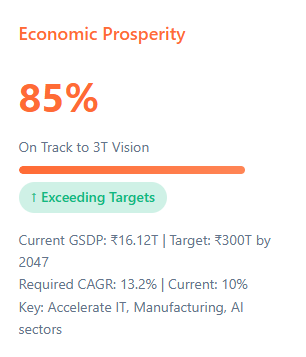
Human Development
Human development shows steady improvement, but specific areas need focused attention. The state recorded a literacy rate of 66.5 percent in the 2011 census, and the goal is to reach 95 percent by 2047. Health coverage expanded through the Aarogyasri program, which now provides ₹10 lakh per family.
Rural women’s literacy remains the most urgent challenge, with the current rate at 53.7 percent. The state must reduce this gap to meet its broader human development targets. Addressing literacy, healthcare, and skills will directly strengthen workforce readiness and support long-term economic growth.
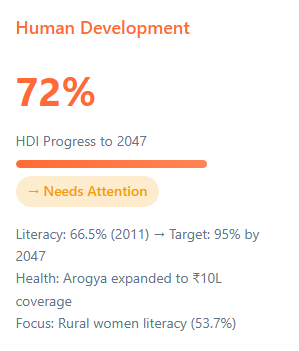
Sustainability
The sustainability pillar continues to progress. Telangana set a target of 26,374 megawatts of solar capacity by 2035. The state’s forest cover is 25 percent, above the national average of 24 percent. The long-term target is 33 percent forest cover by 2047.
These actions support the Net Zero Telangana 2047 plan. Renewable energy expansion, improved environmental planning, and stronger climate policies show that the state is building its transition toward cleaner growth.
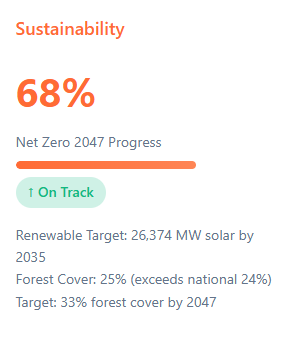
Infrastructure Excellence
Infrastructure programs advanced across multiple sectors during this period. Metro Phase II B, covering 86.1 kilometers and approved at a cost of ₹19,579 crore, is moving forward. Future City completed development work across 30,000 acres as part of its economic and urban expansion plan.
The Musi Riverfront project received ₹375 crore in funding during the second quarter. Highways, mobility systems, and logistics networks also expanded. These upgrades strengthen transport efficiency and support economic clusters that depend on reliable infrastructure.

Governance Excellence
The state continues to strengthen governance systems. Telangana recorded an 88 percent share of its own tax revenue, the highest among central states. This gives the government more financial independence and control over development priorities.
Digital services continue to improve, with MeeSeva serving as a leading model for public service delivery. The AI Governance Mission, created with NASSCOM, is in rollout and aims to increase the use of artificial intelligence in administrative systems. These actions show a clear commitment to transparency, efficiency, and responsive governance.
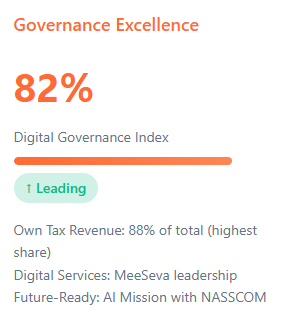
Global Positioning
The state improved its global presence through strong engagement and structured outreach. The Summit 2025 program registered more than 500 companies and 1,300 senior delegates.
The state expects major agreements across sports infrastructure, film production facilities, electric vehicle manufacturing, and artificial intelligence infrastructure. Telangana is shifting from traditional summits to a showcase model in which delegates review large projects on site. This approach increases investor confidence and supports long-term global partnerships.
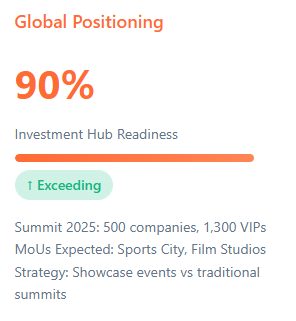
Citizen Sentiment and Perception Index
The Citizen Sentiment and Perception Index for 2025 reflects steady confidence in Telangana’s progress under the Vision 2047 agenda. People reported high satisfaction with governance, infrastructure upgrades, and the state’s investment climate.
Employment perceptions improved as new technology, manufacturing, and logistics projects expanded opportunities. The index also shows that citizens recognize visible changes in city development, digital services, and service delivery systems. These responses indicate that public expectations and the state’s long-term transformation goals remain closely aligned.
Governance Satisfaction, 76 Percent
Citizens reported a governance satisfaction rate of 76%. This response reflects confidence in the state’s management of public services, project execution, and administrative systems. Digital platforms, real-time dashboards, fast approvals, and visible progress in major programs contributed to stronger public trust.
People also recognized improvements in transparency, financial management, and responsiveness across departments. The score shows that citizens see evident progress in areas that influence day-to-day interactions with government.
Infrastructure Quality, 82 Percent
The infrastructure quality score reached 82%, indicating broad public approval of transport upgrades, urban development projects, and ongoing construction activity. People identified improvements in roads, metro expansion, water systems, and public spaces.
Large projects such as Future City, the Musi Riverfront program, and district-level mobility networks increased confidence in long-term planning. This score shows that citizens can see tangible improvements in physical infrastructure across cities and growth corridors.
Employment Opportunities, 71 Percent
Seventy-one percent of respondents expressed a positive view of employment opportunities. Citizens linked this improvement to the growth of IT, manufacturing, logistics, and startup activity. New projects in AI City, Future City, and industrial corridors created expectations of more jobs in both urban and rural areas.
While the score reflects optimism, it also shows that the state must expand skill development and district-level employment programs to meet rising expectations.
Investment Climate Confidence, 88 Percent
The investment climate confidence score reached eighty-eight percent, the highest among all indicators. Citizens reacted strongly to global interest in the state, including the participation of more than 500 companies and 1,300 senior delegates at the 2025 summit.
People also recognized the impact of improved logistics, major infrastructure projects, and strong economic performance. This score shows that the public believes the state is positioned for rapid expansion and long-term investment growth.
Economic Growth Command Center
The Economic Growth Command Center highlights Telangana’s current economic strength and the adjustments needed to meet long-term goals under Vision 2047. The state’s economy stands at ₹16.12 trillion, with 10% annual growth, supported by steady gains in services, industry, and logistics.
The system also tracks regional disparities, noting that economic activity remains concentrated in Hyderabad and nearby districts. It identifies the need to accelerate growth in emerging districts through Future City expansion, industrial corridors, and improved market access.
The command center provides a clear view of how the state must increase productivity, widen district contributions, and strengthen high-value sectors such as IT, manufacturing, and deep tech to meet the 3T economy target by 2047.
Early Warning Alert: Regional Imbalance
The early warning alert highlights a clear imbalance in district-level economic contribution. Hyderabad and Rangareddy account for a large share of the state’s total output, while many districts generate less than ₹25,000 crore in annual GDDP. This gap shows that growth remains concentrated in a small set of urban centers.
To meet Vision 2047 targets, the state must expand industrial activity, infrastructure investment, and employment opportunities across emerging districts. Future City expansion, new corridors, logistics upgrades, and district-based incentives play a key role in correcting this imbalance and building a more even economic structure.
Hyderabad Region Dominates Economic Output
The latest assessment shows a clear concentration of economic activity in the Hyderabad metropolitan zone. Rangareddy contributes ₹3.1 trillion, and Hyderabad contributes ₹2.5 trillion to the state economy.
These two districts account for a large share of total output, while 18 districts produce less than ₹25,000 crore in annual GDDP. This pattern shows that economic strength remains focused in a narrow geographic area.
Risk of High Concentration
The heavy dependence on Hyderabad and Rangareddy creates a structural imbalance that affects long-term economic stability. When growth is limited to a small set of districts, other regions struggle to participate in state-wide development.
This imbalance limits job creation, reduces local revenue in underperforming districts, and increases pressure on urban infrastructure in the metropolitan area. You can see how this concentration conflicts with the broader targets of Vision 2047, which require balanced district-level participation.
Action Needed to Correct Imbalance
The state must expand Future City spillover zones into nearby tier-2 districts to spread economic activity beyond the core metropolitan region. This approach will support the development of new industrial clusters, research centers, and employment hubs outside Hyderabad.
The government also needs to accelerate the development of industrial corridors and logistics hubs in districts with lower GDP levels. These actions will help create new growth centers and reduce long-term dependence on a single economic zone.
GSDP Trajectory to the 3T Vision
The GSDP trajectory outlines how Telangana must transition from its current ₹16.12 trillion economy to the ₹300 trillion target set for 2047. The state records ten percent annual growth, which supports strong economic momentum but remains below the required 13.2 percent compound growth rate for the 3T Vision.
The trajectory highlights the need to expand high-value sectors, such as IT, manufacturing, artificial intelligence, and deep-tech exports. It also shows the importance of strengthening district-level output, improving logistics, and accelerating large projects such as Future City and AI City. Together, these steps define the path the state must follow to achieve the economic scale planned under Telangana Rising 2047.
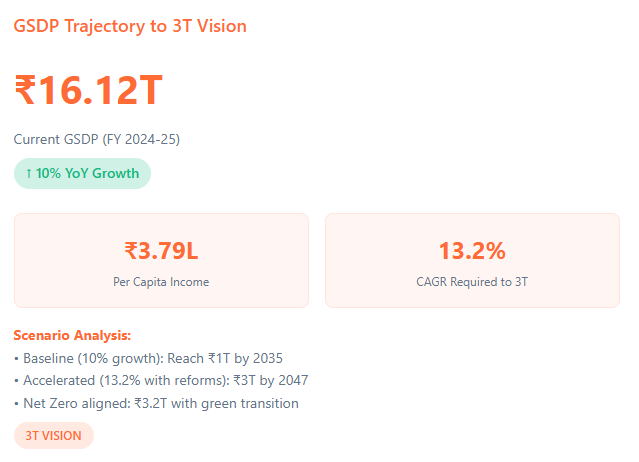
3T Vision – Sectoral Composition (GSVA)
The sectoral composition for the 3T Vision explains how Telangana must rebalance and expand its economic base to reach the 2047 target. You see a clear shift toward high-value industries, especially technology services, advanced manufacturing, deep tech, and green transition sectors.
Services continue to account for the largest share of Gross State Value Added. Still, the long-term path requires more substantial contributions from manufacturing, logistics, modernized agriculture, and AI-driven industries. This composition helps you understand how each sector contributes to the overall growth requirements and how the state can reach the economic scale outlined in Telangana Rising 2047.
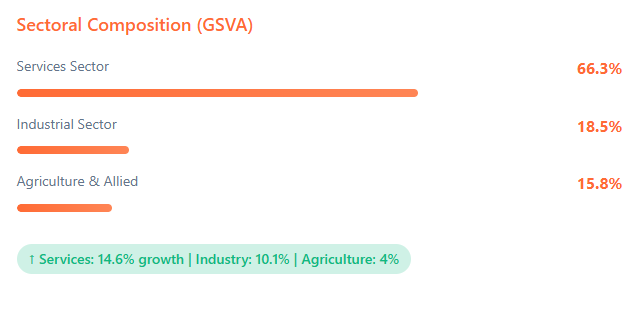
Why Global CEOs Are Choosing Telangana
Global CEOs increasingly view Telangana as a strategic destination for long-term growth because the state combines fast execution, large-scale planning, and strong economic fundamentals.
Senior leadership engagement, primarily through the new showcase-driven summit model, gives decision-makers direct visibility into major projects such as Future City, AI City, and the Musi Riverfront redevelopment. This approach reduces uncertainty and allows investors to assess tangible progress on the ground.
The state’s consistent 10 percent growth, high share of services output, and substantial fiscal autonomy give business leaders confidence in its stability. Infrastructure expansion, including new metro corridors, logistics hubs, and port linkages, strengthens operational efficiency for global companies.
The presence of research centers, large tech partnerships, and deep investments in AI and advanced manufacturing positions Telangana as a hub. These combined factors build a clear case for why global CEOs prefer Telangana for new projects, expansions, and strategic partnerships under the broader Vision 2047 framework.
Positive Growth Momentum
Telangana continues to position itself as one of India’s strongest destinations for global investment. The state’s growth pattern, project execution speed, and long-term planning give CEOs confidence in its stability and competitiveness.
With a focus on large-scale economic zones, technology hubs, and structured investor engagement, the state offers a direct path for companies seeking predictable outcomes and scalable expansion.
Bharat Future City: A High-Scale Investment Magnet
Bharat Future City has become a key driver of the surge in global interest. The zone covers 30,000 acres, making it the most significant economic development area in India. Its planning integrates net-zero standards, mixed-use land development, and advanced logistics networks.
CEOs view this zone as a long-term opportunity to support manufacturing, tech, life sciences, mobility, and green energy within a single integrated ecosystem.
AI City: A Dedicated Global AI Cluster
AI City, spread across 200 acres, strengthens Telangana’s position in advanced technologies. It houses AI research facilities, high-performance computing, and industry-academic labs.
The state’s partnerships with Google, Microsoft, and Amazon give this cluster global reach. Companies value AI City for its research infrastructure, access to talent, and a structured environment for deep-tech development.
The long-term target is to place Telangana among the top 20 AI hubs in the world by 2035.
Infrastructure and Logistics Strength
The state’s infrastructure pipeline attracts companies that need efficient operations. Industrial corridors, dry ports, and logistics parks create a seamless flow for manufacturing and exports. Logistics efficiency has improved by 18 percent due to expanded corridors and better multimodal connectivity.
These improvements reduce operational delays and strengthen supply chain reliability, which is essential for large firms planning long-term investments.
Showcase Investment Model
Telangana’s shift to a showcase-based investment approach, instead of conventional investor summits, has increased direct engagement. The Global Summit 2025 brings together more than 500 companies and 1,300 senior leaders.
These interactions take place within Bharat Future City, giving decision-makers a ground-level view of project readiness. This model provides transparency, fast decision cycles, and direct visibility into the quality of infrastructure and governance.
Comprehensive Ecosystem Support
Global CEOs benefit from strong support networks within the state. Telangana works with major consulting firms such as EY, PwC, Deloitte, and KPMG for due diligence, planning, and policy advisory.
Industry bodies, including CII, FICCI, and NASSCO, help companies build local partnerships, scale operations, and connect with sectoral networks. This structure reduces onboarding times and helps investors integrate easily into the state’s economic system.
Direct CEO Outreach
Chief Minister Revanth Reddy’s direct involvement has strengthened confidence among global leaders. He personally invites Fortune 500 CEOs, engages with them during roadshows, and walks them through planned projects.
This hands-on style signals strong administrative commitment and reduces ambiguity in decision-making. For global companies, this level of engagement is unusual and indicates the seriousness with which Telangana approaches long-term investment.
Recommended Actions (Immediate + 12 Months)
Following the next 122 months, HSccalls for a focused set of interventions that strengthen Telangana’s progress toward the 3T Vision and reinforce momentum across key sectors. Immediate actions should prioritize balanced regional development, stronger economic monitoring, and accelerated infrastructure delivery.
Expanding spillover zones around Bharat Future City, fast-tracking industrial corridors in underserved districts, and upgrading logistics networks will help reduce economic concentration in the Hyderabad region.
Parallel efforts should strengthen the state’s data systems by building a real-time economic monitoring platform that tracks district-level output, employment, investment, and citizen sentiment. Enhancing the execution pace of Metroo Phase II-B, Musi Riverfront works, and AI City Phase 1 will demonstrate visible progress to investors.
Within the 12-month horizon, the state should advance high-impact reforms that support long-term growth. These include improving human development outcomes through targeted literacy programs, expanding digital health coverage, and scaling skills training in AI and manufacturing.
Telangana should also deepen global partnerships, especially ahead of the Global Summit 2025, to secure large MoUs in sectors such as sports infrastructure, EV manufacturing, film production, and advanced technology. Strengthening the policy environment for green energy, data governance, and AI regulation will further support investor confidence and align with Vision 2047 goals.
Fast-track High-Impact Creative and Sports Infrastructure Projects
You need to advance the Sports City project and the film studios proposed by Ajay Devgn and Salman Khan because both projects promise immediate economic returns.
These initiatives create large volumes of direct and indirect jobs, strengthen the tourism and media ecosystem, and position Telangana as a strong competitor to Mumbai for film production.
Fast approval cycles, land allocation, and unified clearances will help convert these MoUs into active construction and early-stage operations.
Accelerate Bharat Future City Phase 1 to Support FDI Growth
Bharat Future City has emerged as a major anchor for global investment interest. To absorb the expected rise in foreign investment, especially after the Global Summit 2025, the state must accelerate Phase 1 infrastructure.
Completing core road networks, power systems, high-capacity data grids, and industrial clusters will ensure that Telangana can attract at least 25 percent more FDI. Visible progress in this zone strengthens global investor confidence and supports the long-term 3T Vision.
Set Up Investor Facilitation Cells in Key Embassies
To convert global interest into committed investment, Telangana should establish Investor Facilitation Cells at its embassies in the top 10 FDI source countries. These cells can provide real-time updates on Telangana’s projects, support due diligence, and coordinate investor visits.
Embassy-linked investor desks also help the state build a continuous engagement model rather than relying on periodic summits. This structure allows global companies to receive accurate information more quickly and clearer approvals, improving the state’s competitive position.
MSME and Startup Ecosystem
Telangana’s MSME and startup ecosystem is expanding steadily and now plays a central role in the state’s long-term growth strategy. The focus has shifted from supporting early-stage entrepreneurship to building a strong, scalable system that links MSMEs, deep-tech startups, and sector-specific innovation clusters.
The state’s network of incubators, such as T Hub and WE Hub, continues to provide mentoring, shared infrastructure, and market access, which helps founders move from idea-stage development to commercially viable products. This ecosystem is further strengthened by partnerships with universities and global technology companies that contribute research support, talent pipelines, and access to advanced tools.
The state is working toward connecting MSMEs and startups with major infrastructure projects such as AI City and Bharat Future City. This linkage helps small firms integrate into supply chains for technology, mobility, renewable energy, and creative industries.
Access to credit, simplified compliance systems, and targeted incentives also support this transition. As Telangana prepares for the 3T Vision, it is positioning MSMEs and startups as core engines of job creation, export growth, and innovation across both urban and regional markets.
Startup Growth Landscape
Telangana’s startup environment is expanding at a steady pace, supported by rising funding activity, strong institutional backing, and growing global interest. The state hosts more than 6,500 registered startups, reflecting both depth and diversity across technology, manufacturing, health innovation, and services.
This growth is measurable in funding outcomes. Startups in Telangana secured $571 million in 2024, a 160% increase over the previous year, positioning the state among the top performers in the national startup ecosystem. Telangana now ranks 4th in India for overall activity, among the top five in deal count, indicating a consistent flow of growth-stage investments.
The government has set an ambitious target to build 40 to 50 unicorns by 2030. This target builds on the success of existing large-scale companies such as Darwinbox, HighRadius, and Zenoti. These companies show that Telangana can nurture firms that scale globally while remaining anchored in the state.
This expansion is supported by a maturing support system that includes accelerators, research-linked incubation programs, and access to advanced technology infrastructure through AI City, T Hub, and university partnerships.
As Telangana moves toward the 3T Vision, the startup sector remains central to its strategy for innovation-led exports, job creation, and the development of new-age industries.

T Hub Impact
T Hub plays a central role in Telangana’s innovation strategy by providing startups with mentoring, research support, and market-ready infrastructure.
It serves as the leading platform for early-stage founders to test ideas, connect with investors, and receive guidance from industry experts. Its programs help startups move from prototype development to commercial deployment with fewer barriers and faster turnaround times.
The hub also strengthens the broader Vision 2047 agenda by linking entrepreneurs with major state projects such as AI City, Future City, and advanced manufacturing clusters. This connection helps startups enter high-growth sectors and integrate into global supply chains.
As the ecosystem expands, T Hub continues to anchor Telangana’s efforts to promote new technology firms, increase innovation-driven exports, and grow the number of scalable companies across the state.
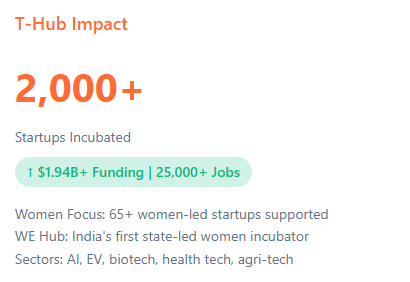
Investment Climate
Telangana’s investment climate shows strong and consistent momentum, supported by rapid infrastructure expansion, high investor participation, and clear policy direction.
The state continues to attract domestic and global companies through its combination of large-scale economic zones, sector-specific clusters, and a governance model focused on direct engagement with industry leaders.
Bharat Future City and AI City anchor this growth, offering planned, high-capacity environments for technology, manufacturing, logistics, and green-energy investments.
The upcoming Telangana Global Summit 2025 reinforces investor confidence by shifting from traditional conferences to immersive showcase events where companies can assess infrastructure, meet policymakers, and explore partnerships on the ground.
Strong participation from global consulting firms, industry associations, and foreign missions enhances due diligence and reduces barriers to investments. With high fiscal autonomy, expanding logistics networks, and active CEO outreach, Telangana is building a stable, forward-looking investment ecosystem suited to long-term growth under the Vision 2047 strategy.
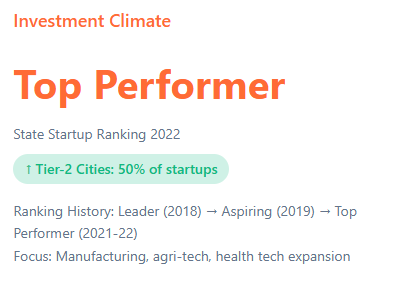
District Economic
High-performing districts show rapid expansion in services, manufacturing, and technology-linked sectors, supported by investment inflows, skilled workforce concentration, and improved infrastructure.
Mid-performing districts display steady progress but need stronger private-sector participation and faster project execution to reach their full potential. Districts with lower activity levels require focused interventions, especially in job creation, connectivity upgrades, and support for MSMEs.
Top Performing Districts
Rangareddy leads the state with a GDDP of ₹3,10,000 crore and a growth rate of 12.5 percent. Hyderabad follows with a GDDP of ₹2,50,000 crore and a growth rate of 11.8 percent. These districts show vigorous economic activity driven by services, modern manufacturing, and continued investment from global and domestic companies.
Medchal–Malkajgiri also shows momentum with a GDDP of ₹1,04,000 crore and a growth rate of 10.2 percent. These districts serve as economic anchors and are central to the 3T strategy because of their infrastructure, workforce, and industry clusters.
Mid-Performing Districts
Sangareddy records a GDDP of ₹65,190 crore with a growth rate of 9.5 percent. The district benefits from expanding manufacturing zones and proximity to Hyderabad, but still needs faster project execution and deeper private-sector involvement.
Districts in this category are positioned to accelerate if supported with better connectivity, incentives for local enterprises, and integration with emerging industrial corridors.
LLow-PerformingDistricts
Mulugu is the lowest performer with a GDDP of ₹8,333 crore and a growth rate of 5.2 percent. This level of output reflects limited industrial activity, low job creation, and weak market access. Low-performing districts need focused programs that address infrastructure gaps, help local businesses scale, and improve access to skills and credit. These interventions are necessary to avoid long-term regional imbalance.
Regional Disparity Alert
Eighteen districts have GDDP levels below ₹25,000 crore. This gap shows how economic activity is concentrated around Hyderabad and nearby neighborhoods, while large parts of the state continue to lag. The disparity also signals the need for consistent monitoring, targeted programs, and district-level planning supported by accurate economic data.
Priority Interventions
Future City corridor extensions can help expand growth beyond the core districts. New industrial clusters built for tier 2 and tier 3 cities can help distribute jobs and investment more evenly.
Balanced regional development programs are needed to support districts with low economic activity through targeted support for MSMEs, improved logistics, and skills training. These interventions will help the state progress toward the Vision 2047 target without widening regional gaps.
Human Development and Social Progress
Telangana Rising 2047 frames human development as a core pillar of long-term economic strength. The agenda focuses on improving education quality, expanding access to healthcare, and strengthening social protection systems.
The goal is to ensure that every district benefits from economic growth and that communities gain the skills and support they need to participate in the state’s transformation. The state’s strategy emphasizes equal access to services, stronger outcomes for women and youth, and a clear shift toward data-driven welfare delivery.
Critical Gap Identified
A clear development gap has emerged between high-growth districts and those with limited economic activity. While Hyderabad, Rangareddy, Medchal, and Sangareddy record strong GDDP levels, many interior districts remain below the ₹25,000 crore threshold.
This uneven growth pattern signals the need for direct interventions that expand industrial corridors, extend Future City infrastructure, and build tier 2 and tier 3 economic clusters. Telangana Rising 2047 highlights this disparity as a priority challenge that must be addressed to ensure balanced progress across all regions.
Scale of the Gap
The data shows a clear literacy divide between rural women and the rest of the population. Rural women have an acy rate of 53.7 percent, which is significantly lower than the 81.1 percent rate. Overall, rural literacy stands at 57.3 percent. The gender gap remains wide at 17.1 percentage points. These figures point to an urgent need to strengthen access to basic education for women in rural areas.
Why This Gap Matters
Low literacy affects women’s participation in economic activity, access to government programs, health outcomes, and mobility. It also slows progress on long-term goals under Telangana Rising 2047, which depends on the inclusion of women in the workforce, digital economy, and community-level leadership.
Required Action
The state needs to launch a dedicated Rural Women Literacy Mission to improve women’s functional and formal literacy in villages. The mission can operate through the Women, Farmer, Youth Club Model to create community-level support networks.
This approach allows you to address gender barriers, rural disadvantage, and socio-economic constraints within a single program structure. The intervention must target enrollment, retention, digital access, and measurable literacy improvement across districts.
Education and Literacy Status
Telangana Rising 2047 highlights education and literacy as core drivers of long-term human development. The state shows steady gains in school enrollment and digital access, yet literacy disparities remain clear across districts, gender groups, and rural populations.
Urban areas record stronger outcomes while rural regions continue to face gaps in foundational learning and women’s literacy. Strengthening school quality, improving teacher capacity, and expanding adult learning programs remain central to the state’s strategy. The goal is to create an education system that supports future skills, social mobility, and equal opportunity for every learner.
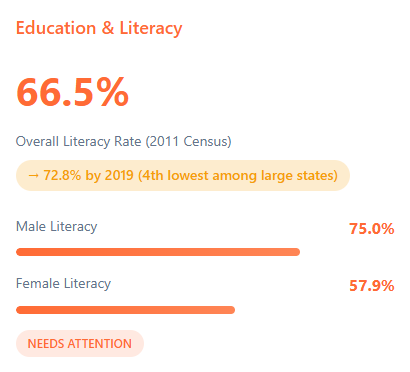
Health and Wellness Progress
Telangana’s progress in health and wellness supports the broader goals of Vision 2047, which focus on building a productive, resilient, and future-ready population. The state continues to improve access to healthcare, strengthen frontline systems, and expand public health infrastructure.
These improvements help reduce disease burden, improve life expectancy, and raise overall social well-being. Better health outcomes also support workforce productivity, more substantial human capital, and long-term economic growth.
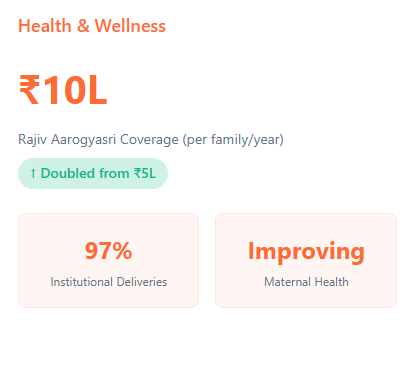
Skill Development and Future Ready Workforce
Telangana Rising 2047 positions skill development as a core driver of inclusive growth, to prepare the workforce for technology-intensive sectors that will shape the state’s long-term economic trajectory. The focus is on building talent pipelines for AI, advanced manufacturing, biotech, EV systems, green mobility, deeptech research, and digital services.
Programs across higher education, polytechnics, rural skilling centers, and industry-linked academies aim to develop a workforce capable of meeting the employment demands of the 3T Vision.
By expanding job-linked training, strengthening partnerships with global companies, and improving access for youth in tier 2 and rural regions, Telangana seeks to build a workforce that is productive, adaptable, and capable of contributing to sustained economic growth.

Gender Parity Challenge
Telangana Rising 2047 identifies gender parity as a core area that needs targeted action, especially in education, workforce participation, and access to growth opportunities. The state continues to face sizeable gaps between men and women in literacy, skilling, and employment.
Rural women face the most significant disadvantage, hindering social mobility and limiting the talent pool available to future industries. Addressing this challenge requires targeted programs that expand literacy, improve access to skills training, and strengthen women’s economic participation in both rural and urban areas. This emphasis supports inclusive growth and ensures that the state’s long-term transformation vision benefits all sections of society.
Current Situation
The indicators reveal a serious literacy gap that affects women, rural communities, and schoolchildren. The low literacy rate among rural women is the most urgent concern. The data also shows wide gaps in literacy between men and women, as well as between urban and rural areas.
These disparities directly affect long-term human development, workforce readiness, and the state’s ability to meet the goals set under Telangana Rising 2047.
Rural Women Literacy Gap
Rural women record a literacy rate of 53.7 percent, which is significantly lower than both rural male literacy and urban female literacy. This gap restricts economic mobility, reduces access to information, and limits participation in skill-based programs. The data confirms that rural women face layered disadvantages due to geography, gender, and socioeconomic conditions.
Gender Literacy Gap
The difference between male and female literacy remains large. Male literacy is at percent, and female literacy is at 0.9 percent. This 17.1 percentage-point gap shows that women do not have equal access to education. The gap also indicates that current interventions need stronger targeting to address structural disadvantages that limit women’s progress.
Urban Rural Literacy Divide
Urban areas have much higher literacy rates than rural regions. The difference, measured at 23.8 percentage points, shows how location affects access to education, the quality of schooling, and the continuity of learning. This divide widens social inequality and reduces opportunities for rural youth who need literacy for employment and lifelong learning.
High School Dropout Levels
The school dropout rate from Class I to X is 38.21 percent, indicating that a large share of students leave the system before reaching higher secondary education. This level of dropout restricts the creation of a skilled workforce. It also affects young women more severely due to early marriage, household responsibilities, and social norms that reduce retention in schools.
Need for Immediate Action
The status marked as “Concerning, requires immediate action” is accurate. The gaps in literacy and schooling pose risks to the state’s long-term transformation targets. Without direct intervention, these gaps will slow down progress in health, employment, and gender equality.
Strategic Direction for Intervention
The data supports the need for a Rural Women Literacy Mission that links with the Women–Farmer–Youth Club Model. This approach improves access to learning and promotes outreach in local areas. The literacy mission can also focus on school continuity, adult literacy, digital learning, and family-based engagement to reduce dropout rates.
Women-Farmer-Youth Club Innovation
The Women–Farmer–Youth Club Innovation strengthens community-level development by combining three high-impact groups into a single model. It supports the goals of Telangana Rising 2047 by connecting women’s literacy, farmer productivity, and youth skill development.
The model helps districts with low literacy and uneven economic growth by creating shared learning spaces, improving access to training, and encouraging participation in state programs. It also supports rural transformation by integrating education, livelihoods, and technology adoption within a single, coordinated framework.
Women–Farmer–Youth Club Innovation serves as Telangana’s integrated community development model. The state introduced it as a flagship initiative to drive inclusive progress and presented it at the Global Summit 2025 to highlight how coordinated local networks can improve social and economic outcomes.
Purpose and Strategic Role
The model strengthens district- and village-level development by bringing together women, farmers, and youth into a single, structured platform. It helps you address local constraints in literacy, livelihoods, skills, and digital access through a unified mechanism rather than separate interventions. By linking these groups, the model increases participation in public programs and accelerates rural transformation.
Integrated Framework
The approach includes five connected pillars. Women’s empowerment focuses on improving literacy, financial independence, and leadership roles in community activities. Farmer-led economic development supports agricultural productivity, market access, and technology adoption.
Youth skill development expands access to future-ready training, connecting young people to emerging sectors. Digital literacy and AI adoption help communities use digital services, online education, and data-driven farming tools. Community-driven social mobility brings these elements together by encouraging local collaboration and shared progress.
Impact Potential
The model directly supports Telangana Rising 2047 by linking human development, economic growth, and digital transformation. It also provides a structured path to address persistent rural challenges such as low female literacy, uneven income growth, and limited access to skills programs. By using community networks as the foundation, the initiative creates a system in which each group strengthens the others, improving long-term social and economic mobility across districts.
Recommended Actions
The actions focus on reducing the literacy gap, expanding community-driven development models, and building future-ready skills for women and youth. These steps directly support long-term social mobility and help connect rural communities with the economic priorities of Vision 2047.
Mission Shakti 2047
Mission Shakti 2047 sets a clear goal to raise rural women’s literacy to 90 percent by 2030. This requires targeted learning interventions that reach households with limited access to formal education. Mobile education units can take learning directly to remote villages, while digital learning kits provide basic literacy, numeracy, and digital skills through simple tools. These efforts strengthen the foundation needed for higher participation in economic and social programs.
Expand Women–Farmer–Youth Clubs
The expansion of Women–Farmer–Youth Clubs to all 10,909 gram panchayats gives every village a structured platform for inclusive development. These clubs can add digital literacy modules, financial learning programs, and awareness sessions on AI-based tools that support agriculture, household management, and community services.
This approach helps you create a uniform model where women, farmers, and young people work together to improve local outcomes.
Women-Focused Tech Skills
Women-focused technology skills are essential for preparing the workforce for Future City and related economic clusters. A partnership with WE Hub can help you build training pathways in AI, electric vehicle technologies, green technologies, and digital transformation roles.
These training programs also support direct job placement in AI, EV, biotech, health tech, and agri-tech companies connected to the state’s innovation ecosystem. This helps women transition into high-growth sectors and improves long-term employment opportunities across rural and urban areas.
District Literacy Heat Map
The district literacy heat map highlights uneven educational progress across the nation and shows how regional variation affects long-term outcomes. Districts with more vigorous economic activity report higher literacy, while several rural regions fall behind state averages.
These gaps directly influence workforce readiness and limit participation in emerging opportunities linked to Vision 2047. The analysis shows that many districts continue to struggle with female literacy and rural enrollment, which restricts community progress.
Understanding these differences helps you design targeted literacy programs, improve school retention, and focus resources on districts facing persistent challenges.
District Performance Summary
Hyderabad reports the highest literacy rate at 83.25 percent. Male literacy is 88.5 percent, and female literacy is 78 percent. The 10.5-point gender gap shows that women still fall behind, but it is narrower than in other districts.
The city’s stronger education access and urban advantages drive these numbers. Rangareddy reaches 75.87 percent literacy. Men reach 82.1 percent, and women reach 69.5 percent. The 12.6 poi12.6-pointgap shows that women face barriers even in fast-growing districts with intense economic activity. Warangal stands at 65.11 percent literacy. Male literacy is 73.2 percent, and female literacy is 56.8 percent.
The 16.4-point gaps show persistent inequality. Warangal’s numbers reflect stalled improvement in the rural and semi-urban belts. Karimnagar records 64.15 percent literacy. Male literacy is 72.5 percent, and female literacy is 55.6 percent. The 16.9-point gap is among the widest among the listed districts. This suggests that female education programs have not reached full scale. Mahabubnagar reports the lowest literacy rate at 55.04 percent.
Male literacy is 65.3 percent, and female literacy is 44.2 percent. The 21.1-point gender gap is the largest in this dataset. This level of inequality blocks economic participation, slows social progress, and restricts rural families from benefiting from Vision 2047 investments.
Gender Gap Analysis
The data show that gender inequality accounts for most of the district-level differences. Hyderabad has the narrowest literacy gap. Rangareddy sits at a moderate level, while Warangal and Karimnagar show deep gaps.
Mahabubnagar shows the widest gap, with more than one-fifth of women left out of basic education. This gender gap reduces household income potential, lowers digital participation, and limits opportunities for skill development programs linked to Future City projects, agri-tech pathways, and emerging technology clusters.
Urban Rural Variation
Hyderabad’s performance reflects strong access to schools, digital infrastructure, and public services—districts with higher rural populations exhibit male literacy, lower school completion rates, and gender gaps.
These differences directly affect how districts participate in Vision 2047’s economic pathways, such as AI, EVs, green technology, and digital services. Rural districts require a separate strategy focused on access, retention, and women-centered learning systems.
Implications for Vision 2047
You need to address these literacy gaps to create a unified talent base for Vision 2047. Without targeted district-level programs, the state loses the chance to expand women’s workforce participation, improve rural productivity, and strengthen human development indicators. Districts with low female literacy will struggle to meet demands for future technologies, digital transformation, and skill-based jobs linked to the 3T economy.
Strategic Direction
To solve these gaps, you need district-specific interventions such as rural literacy missions, school retention programs, women-focused digital learning, and stronger support systems for first-generation learners. Districts performing above the state average can support peer learning models for low-performing districts. This approach strengthens the Vision 2047 goal of creating an equal, education-driven, and future-ready Telangana.

HDI Forecasting to 2047
The HDI projections indicate that Telangana could enter the high human development band by 2047 if it sustains substantial gains in education, health, and income. The trajectory depends on how quickly the state closes the rural and gender literacy gaps, expands future-ready skills, strengthens public health outcomes, and raises district-level economic participation.
A focused strategy that links education reform, women’s literacy missions, social protection, and workforce development to the 3T economic model ensures steady HDI improvement across all regions. This shift supports the broader Vision 2047 goal of building a skilled, healthy, and economically secure population that can participate in advanced technology-driven growth.
2025 – Current Baseline
The 2025 baseline reflects uneven progress across education, health, and regional economic indicators. Core strengths include high institutional delivery rates, expanded health coverage, and rapid urban economic growth led by Hyderabad, Rangareddy, and Medchal.
At the same time, several districts continue to show low literacy levels, wide gender gaps, and slower GDP growth. Rural women’s literacy remains a significant concern, and dropout rates remain high.
These conditions define the starting point for Vision 2047 and highlight the need for focused interventions in literacy, skills, district development, and inclusive growth to support long-term social and economic transformation.
The 2025 baseline establishes where Telangana stands before moving toward the Vision 2047 milestones. The state shows progress in literacy, health outcomes, and income levels, but the gains remain uneven across regions and demographic groups. This baseline acts as the starting point for long-term human development, sectoral modernization, and inclusive growth.
Literacy Status
The estimated literacy rate for 2025 stands at 72.8 percent. This indicates improvement since the last census, but still places the state among the lower-ranked large states. Female literacy and rural literacy continue to pull down the overall rate, and district-level disparities remain wide. These conditions require targeted learning programs, stronger school retention systems, and adult literacy expansion to raise the statewide average.
Health Status
Health indicators show improvement due to expanded coverage under Rajiv Aarogyasri and higher access to institutional care. The rise in insurance support has reduced out-of-pocket expenditure for families, and higher institutional delivery rates have strengthened maternal and child health outcomes.
These improvements provide a vital enhancement, but the system still needs broader access in rural areas and better district-level resource distribution.
Per Capita Income
The per capita income for 2025 stands at 3.79 lakh rupees. The growth reflects strong performance in urban districts, especially Hyderabad and Rangareddy. However, similar gains have not been achieved in all districts, and regional imbalances remain a concern. To sustain higher income levels, the state needs broader job creation, skill development, and expansion of district-level economic activity.
Relevance for Vision 2047
This baseline provides the foundation for the state’s long-term transformation plan. Telangana Rising 2047 requires a sharper focus on human capital, digital readiness, district development, and equal opportunities across gender and geography. The current literacy, health, and income levels help define the scale of interventions required to lift the state onto a high-growth, high-human-development trajectory by 2047.
2030 – Milestone 1
Telangana’s first significant milestone for Vision 2047 marks a shift from foundational progress to structured acceleration. By 2030, the state is expected to strengthen literacy outcomes, broaden health coverage, and raise income levels across both urban and rural regions.
The focus is on reducing gender gaps in education, expanding community health access, and improving district-level economic performance. This milestone represents the transition from baseline readiness to measurable advancement, ensuring that human development, skills, and regional growth move in a coordinated direction that supports the long-term transformation goals of Telangana Rising 2047.
The 2030 milestone marks the first major checkpoint in Telangana’s long-term transformation plan. It establishes clear targets for literacy, health access, and workforce preparation, laying the groundwork for the broader objectives of Vision 2047. Each target focuses on correcting structural gaps that restrict social mobility and economic expansion, especially in rural and low-literacy districts.
Literacy Target
The state aims to raise literacy to 85 percent by 2030. This shift requires substantial gains in rural areas and among women, where literacy gaps remain wide. Achieving this target depends on consistent school attendance, community support systems, and adult education programs. The goal sets a clear shift from incremental progress to large-scale improvement.
Universal Health Coverage
Universal health includes expanding access to primary healthcare, improving service delivery in rural districts, and ensuring that families can use public health programs without financial barriers. Better health outcomes improve productivity and support long-term economic growth.
Skills University Readiness
The Future Skills University and Young India Skills University must be fully operational by this milestone. Their role is to train a tech-ready workforce in AI, EV systems, digital services, and automation. By 2030, these universities should run at full capacity to meet the state’s requirement for skilled workers in Future City projects and emerging industries.
Dropout Rate Reduction
The state must reduce the school dropout rate from 38.21 percent to 15 percent. This requires action in early childhood education, access to learning resources, safe school infrastructure, and targeted interventions for rural girls. Lower dropout rates directly support the 2030 literacy target and improve long-term income potential.
Statewide Women Literacy Mission
A statewide rollout of the Women Literacy Mission is essential. This program must provide mobile learning units, digital kits, and community-based study support for rural women. Improving women’s literacy drives progress across family income, health, and economic participation. This mission also connects with the Women–Farmer–Youth Club framework to scale inclusion at the grassroots level.
This milestone marks the shift from foundational growth to structured acceleration, ensuring that literacy, health, and skill development progress in sync with Telangana Rising 2047’s broader vision.
2040 – Milestone 2
2040 marks the consolidation stage of Telangana’s long-term transformation plan, where the state moves from correcting structural gaps to achieving advanced human development outcomes. By this point, foundational improvements in literacy, health, skills, and income must translate into sustained gains that position Telangana for its 2047 goals.
The milestone focuses on three outcomes: achieving near-universal literacy, expanding access to high-quality healthcare for all age groups, and creating a fully future-ready workforce aligned with high-growth sectors. It also expects districts with historically low development indicators to show measurable improvement, supported by targeted interventions and advanced digital governance tools.
The 2040 milestone marks the stage at which Telangana moves from foundational improvements to advanced human development outcomes. The focus is on creating a skilled, healthy, and literate population that can participate in a high-growth, AI-enabled economy. Each indicator reflects a clear progression toward the Vision 2047 benchmark of a high-performing, innovation-driven state.
Target Literacy: 93 Percent
Reaching a literacy rate of 93 percent by 2040 requires sustained improvements in adult education, school retention, and women’s literacy. This target builds on earlier interventions that reduced dropout rates and strengthened rural learning systems.
The milestone expects uniform progress across districts, especially in regions with historically low outcomes. You need consistent monitoring of district performance to ensure that literacy gains remain steady and that gender and rural gaps continue to narrow.
Life Expectancy: 78 Years
By 2040, life expectancy should rise to 78 years. This increase depends on steady improvements in maternal health, child nutrition, non-communicable disease prevention, and accessible primary care. Strengthening digital health records, telemedicine systems, and early detection programs supports this shift. Preventive care must reach every district to improve health outcomes uniformly, rather than concentrating in urban areas.
Per Capita Income: ₹12 Lakh
A per capita income target of ₹12 lakh indicates a transition into a higher-income growth phase. To sustain this, Telangana needs district-level expansion in manufacturing, services, and technology-driven sectors. Growth in AI, biotech, EVs, and automation-based industries should generate stable employment pathways.
This milestone also requires a steady rise in formal jobs, women’s workforce participation, and the adoption of advanced skills.
High AI Integration in Education and Preventive Healthcare
AI should play a central role in improving learning outcomes and healthcare efficiency by 2040. In education, AI-driven personalized learning, adaptive assessments, and digital learning analytics should help schools track student progress and identify learning gaps.
Teacher support systems using AI must ensure outcome-based improvements across government and private schools. In preventive healthcare, AI must support early diagnosis, risk prediction, maternal health tracking, and district-level disease monitoring. These tools provide timely alerts, improve decision accuracy, and help health teams respond faster.
What This Milestone Represents
Milestone 2040 sets the stage for the final phase of Vision 2047. At this point, Telangana should have a well-educated population, strong health outcomes, higher incomes, and broad adoption of AI in public systems. These shifts build the foundation for a high Human Development Index and advanced economic competitiveness by 2047.
2047 Vision Achievement
Telangana reaches its target stage in 2047 with substantial progress in education, health, income, and digital readiness. The state completes its transition toward a high-performing human development model with near-universal literacy, longer and healthier lives, and widespread adoption of AI-enabled public systems.
Economic growth stabilizes at a scale where skilled workers, advanced technologies, and district-level development move together. This outcome reflects sustained improvements made across earlier milestones, including reduced dropout rates, stronger women-focused learning programs, and broad access to preventive healthcare.
The 2047 achievement marks Telangana’s shift into a mature, future-ready economy supported by continuous learning, digital tools, and strong social mobility.
Telangana reaches its target stage in 2047 with strong outcomes across literacy, health, gender equality, and workforce readiness. These gains complete the long-term transformation planned under the Telangana Rising 2047 framework and position the state among the highest performers in India.
Literacy Achievement
Telangana has a literacy rate above 95 percent. This result reflects sustained investments in rural education, women-focused literacy programs, and efforts to reduce dropout rates. It also confirms that the state succeeded in expanding access to continuous learning across districts and socioeconomic groups.
Human Development Performance
By 2020,estateee will be among the top three Indian states in the Human Development Index. This improvement reflects steady progress in life expectancy, income, and educational attainment. District-level disparities decrease as health coverage expands and preventive care improves.
Gender Parity
The state achieves gender parity across education and workforce participation. The gender literacy gap is closing as women in rural and urban regions achieve near-equal learning outcomes. Women’s involvement in digital skills, AI-oriented programs, and Future City workforce pipelines strengthens the overall human capital base.
Workforce Readiness for the 3T Economy
Human capital is fully ready for the Technology, Tourism, and Trade economy. The workforce trained through AI, EV technology, robotics, automation, and digital transformation programs supports high-end services, advanced manufacturing, and global innovation roles. The shift marks the completion of the long-term transition toward a skills-driven economic model.
Infrastructure and Urban Transformation
Telangana Rising 2047 accelerates long-term urban and infrastructure upgrades across transport, housing, public services, and digital systems. The state strengthens its core assets to support rapid economic expansion, future-ready cities, and balanced district-level development. These improvements create a unified network that connects high-growth urban centers with emerging tier 2 and tier 3 regions and prepares the state for the demands of the 3T economy.
Bharat Future City – India’s Largest Economic Zone
Bharat Future City serves as the core engine of Telangana Rising 2047, designed to host advanced industries, next-generation services, and large-scale innovation clusters. The zone integrates AI, EVs, green technology, robotics, and digital manufacturing into a unified ecosystem. It supports high-skilled employment, significant global investments, and rapid technology diffusion across districts. The project strengthens the state’s long-term economic strategy and positions Telangana as a national leader in future economic development.
Strategic Role
Bharat Future City strengthens Telangana’s long-term economic direction and supports its goal to lead national urban development. The project serves as a central hub for future industries and advanced services. Its design focuses on technology-driven growth and sustainable planning. The state has positioned this zone as a large-scale net-zero economic district that can attract global investors and support high-skilled employment.
Development Status
The project is progressing in a positive direction. Telangana has already framed it as a next-generation economic zone that integrates climate goals with industry expansion. The zone’s net-zero framework gives it a competitive advantage because global companies now assess environmental performance before investing.
National and Global Positioning
The project improves the state’s standing in the national competition for high-value investments. Bharat Future City is designed to meet global expectations for clean energy, green industrial standards, and smart infrastructure. Its scale and structure place Telangana among states preparing early for future economic shifts.
Alignment with Vision 2047
The zone directly supports Telangana Rising 2047 by creating new industrial clusters for AI, digital manufacturing, clean mobility, robotics, and green technology. It also strengthens district-level development through supply chains that extend beyond Hyderabad. Bharat Future City anchors the state’s aim to build a modern 3T economy of technology, trade, and tourism supported by sustainable growth models.
Project Scale
Bharat Future City represents an extensive multi-decade urban and economic development program that supports Telangana’s long-range growth plan. The project covers extensive land zones dedicated to clean energy industries, advanced manufacturing, digital services, and research facilities. Its scale positions it as a national benchmark for building a next-generation economic district that integrates net-zero standards. By combining industry clusters, transport networks, housing, and digital infrastructure within a unified plan, the project supports the broader Vision 2047 goal of creating a high-productivity economy built on technology, skills, and sustainable development.
Core Development Footprint
The project covers a core development area of 30,000 acres, equal to 121.4 square kilometres. This makes the zone larger than Chandigarh, which spans 114 square kilometres—the scale of land allocation positions the project among the largest planned economic districts in India.
Wider Urban Authority Area
The project operates within an expanded urban development authority area of 765 square kilometres, equal to 1,85,000 acres. This extended footprint supports long-term industrial growth, new mobility networks, housing, logistics, and digital infrastructure. It also allows the government to plan interconnected clusters rather than isolated parcels of development.
Investment and Financial Model
The government plans to invest between 30,000 and 40,000 crore rupees over the next five years. The project uses a combined funding model that includes government spending, public-private partnerships, and participation from global financial institutions. This approach distributes risk, supports steady capital inflow, and ensures accountability across multiple stakeholders.
Net Zero Commitment
The project is designed as India’s first net-zero industrial smart city. This commitment covers energy systems, building standards, industry operations, waste management, and mobility. The design aims to reduce emissions at the source rather than rely only on offsets. This makes the project a reference model for large-scale green economic zones.
Strategic Relevance for Vision 2047
The scale of the project allows Telangana to build a long-term economic base that supports high-growth sectors linked to the state’s 3T economy. The combination of land size, structured governance, funding stability, and net zero planning strengthens the state’s position in national and global investment networks. The project serves as a central pillar of the broader goal to transform Telangana into a high-productivity economy by 2047.
Ten Development Zones
The Ten Development Zones represent the core spatial strategy of Telangana Rising 2047. Each zone is designed to distribute growth, expand industrial capacity, and support balanced regional development. The framework links economic clusters, logistics corridors, innovation districts, and residential townships to create a connected, future-ready urban network. These zones help the state move from concentrated growth toward a multi-node model that strengthens both urban and rural regions while supporting the long-term goals of the 3T economy.
The Ten Development Zones form the core spatial structure of Bharat Future City and support Telangana’s long-term economic direction under Vision 2047. Each zone is designed to create clear economic clusters while expanding the state’s capacity in advanced technology, manufacturing, and next-generation services. The design shifts growth from a single urban core to a distributed network that strengthens both industrial expansion and human development.
Technology and Innovation Zones
The first set of zones focuses on high-growth industries. The AI City anchors research, product development, and large-scale AI deployment. The Pharma and Life Sciences zone strengthens Telangana’s existing leadership in global drug production and contract research. The EV Manufacturing zone supports mobility, battery systems, and charging infrastructure. Together, these zones create a base for the 3T economy and offer opportunities for startups and established firms.
Creative, Knowledge, and Skill Development Zones
The Entertainment District expands film production, gaming, digital content, and large-format media facilities. The Knowledge Infrastructure zone supports higher education, skills training, and applied research centers that link directly with industry needs. These zones help create a workforce prepared for automation, clean mobility, biotech, and AI-driven services.
Industrial, Logistics, Aerospace, and Clean Energy Zones
The Logistics and Industrial Parks zone expands warehousing, supply chain operations, and multimodal connectivity. This zone reduces manufacturing operational costs and improves export readiness. The Aerospace, Defence, and Clean Energy zone supports advanced production, component manufacturing, and renewable technologies. These clusters help Telangana reduce import dependence and build domestic capacity in emerging sectors.
Forest Zone and Ecological Balance
The tenth zone is the Forest Zone, covering 15,000 acres and accounting for half of the city’s area. This zone serves as a long-term ecological buffer and pr, helping maintain mental stability. It integrates green belts, biodiversity regeneration, and nature-based solutions for heat, air quality, and water management. The zone positions Bharat Future City as India’s first large-scale economic region designed with a permanent natural core.
Integrated Role Across Vision 2047
Together, the Ten Development Zones create a comprehensive model that supports high-growth industries, skilled human capital, industrial expansion, green technology, and ecological security. The framework helps Telangana move toward its long-term target of building a globally competitive, net-zero, and innovation-driven economic region.
Connectivity Advantage
Telangana Rising 2047 positions Bharat Future City as a strategically connected economic hub that links major transport corridors, industrial belts, and urban clusters. The location offers direct access to national highways, regional logistics networks, and upcoming high-speed mobility. This connectivity supports faster movement of goods, reduces travel time, and strengthens access between Hyderabad and emerging growth districts. The integrated transport design ensures smooth coordination between road networks, logistics parks, industrial zones, residential sectors, and green areas. This approach improves overall efficiency and supports long-term economic growth.
The connectivity plan for Bharat Future City strengthens its role as a significant economic hub in Telangana Rising 2047. The state is building a transport network that links the city to ports, airports, metro systems, and logistics nodes. This structure supports faster cargo movement, improves worker productivity, and strengthens supply chains for key industries.
New Greenfield National Highway to Machilipatnam Port
The upcoming greenfield national highway directly connects the city to Machilipatnam Port. This link improves export access for AI, EV, pharma, aerospace, and clean energy sectors. It reduces freight travel time and creates a continuous economic corridor between inland Telangana and the eastern coast.
This highway also strengthens long-term industrial growth by providing stable, faster access to a major port without negotiation.
Metro Phase II B: RGIA to Future City (39.6 km)
Metro Phase II B connects Rajiv Gandhi International Airport to Bharat Future City over a 39.6 km stretch. This connection supports daily workers, airport-linked businesses, tourism, research institutions, and advanced manufacturing units within the region.
You get consistent travel times between the airport and the new city, which improves investment and supports long-term urban development. The connection also improves public transport coverage across the southern and eastern belts of Hyderabad.
Airport, Expressway, and Multimodal Logistics
The city’s transport plan integrates the expressway and logistics hubs into a single system, allowing cargo to move quickly between air, road, and industrial parks.
You get smoother freight flow because the logistics nodes sit next to expressways and planned metro routes. The integrated design reduces travel delays and supports industries that depend on high-speed shipping, including pharma, electronics, aerospace, and precision manufacturing.
This approach also strengthens the city’s position as a national logistics hub, because all major transport modes connect within a single planning zone.
Recommended Actions
This section outlines priority interventions that support Telangana Rising 2047 and strengthen Bharat Future City’s role in the state’s long-term transformation. These interventions focus on faster connectivity delivery, efficient logistics planning, and coordinated infrastructure execution that links industrial zones with the airport, metro network, and port access. These recommendations help the state build a high-performing transportation system that supports industry growth, job creation, and sustainable urban expansion.
Accelerate Funding Approvals
The state needs to secure international financing to support early-stage infrastructure. Faster clearance reduces delays in road networks, utilities, and the city’s core public assets. This also helps you build predictable construction schedules and a more substantial investment.
Prioritise Land Allocation for Private Sector Commitments
The Global Summit 2025 MoUs brought in high-value proposals across AI, mobility, clean energy, manufacturing, and design services. You need to move these commitments from intent to execution. Assign land parcels for the first set of investors and make zoning decisions clear. Early land allocation reduces uncertainty for companies planning factories, labs, and logistics bases. It also encourages additional investors to engage with the project.
Position Future City in the Global Benchmark Group
Future City aims to compete with established global economic hubs. The state should position the project in direct comparison with Singapore’s Jurong, Dubai’s DIFC, and Saudi Arabia’s NEOM. This comparison helps define standards for regulation, sustainability, transport quality, and liveability. Future City holds a clear advantage through its net-zero foundation, which gives it a differentiated identity in the global economic zone category. You can use this advantage to attract companies that require long-term carbon-neutral operations, such as clean energy manufacturers, AI data centers with green power demand, and advanced industrial clusters.
Strengthen Strategic Communication for Investors
Future City’s value should be communicated through consistent messaging that highlights size, planned infrastructure, workforce availability, and regulatory clarity. Investors need direct visibility into the zoning structure, growth phases, and the support available for strategic projects. Clear communication helps you maintain a strong relationship with global companies that compare multiple regions before finalizing their plans.
Consolidate Government and PPP Delivery Systems
The project requires coordinated execution across multiple departments and private partners. You should unify approvals, dispute resolution, and construction tracking through a single operational structure. This avoids duplication and improves reliability for companies that build within the first phase of the economic zone.
Metro Rail Expansion Phase II B
The Metro Rail Expansion Phase II B strengthens Telangana’s long-term urban strategy under Telangana Rising 2047. The project connects the Rajiv Gandhi International Airport and Bharat Future City through a 39.6-kilometre corridor that supports high-growth districts. The network improves daily travel efficiency, reduces road congestion, and supports large-scale residential and commercial development planned around the corridor. It also enables seamless links to the expressways and multimodal logistics, making the region more competitive for global investors and improving access for the workforce that will serve the 3T economy.
Corridor Details
This section highlights how the new metro corridors strengthen the long-term mobility within Telangana Rising 2047. The corridors extend high-capacity transit to key growth zones, connect residential and economic clusters, and support the shift toward a cleaner, more efficient transport system. Each corridor increases network reach, reduces road pressure, and improves access to Future City, the airport region, and upcoming industrial hubs.

Funding Model (50:50 PPP + Multilateral)
The funding model uses an equal partnership between the government and private players, supported by multilateral agencies. This structure reduces the state’s financial burden, attracts long-term private-sector commitment, and ensures stable capital flows for large infrastructure projects. Multilateral agencies strengthen the model through low-interest financing, project risk assessment, and independent oversight. The combined approach improves execution speed, builds investor confidence, and supports Telangana’s broader goal of developing Future City as a high-capacity economic hub under the Telangana Rising 2047 program.

Musi Riverfront Development Project
The Musi Riverfront Development Project marks a significant step in Telangana’s long-term urban renewal strategy under the Telangana Rising 2047 Vision Acceleration and Transformation Intelligence framework. The project aims to convert the river stretch into a continuous, well-planned urban ecosystem that supports housing, mobility, public spaces, and water management. It strengthens Hyderabad’s resilience, reduces long-standing environmental stress, and creates new economic activity zones along the river corridor. By combining ecological restoration with modern urban design, the project positions the Musi basin as a strategic anchor for future urban expansion and quality-of-life improvements across the metropolitan region.
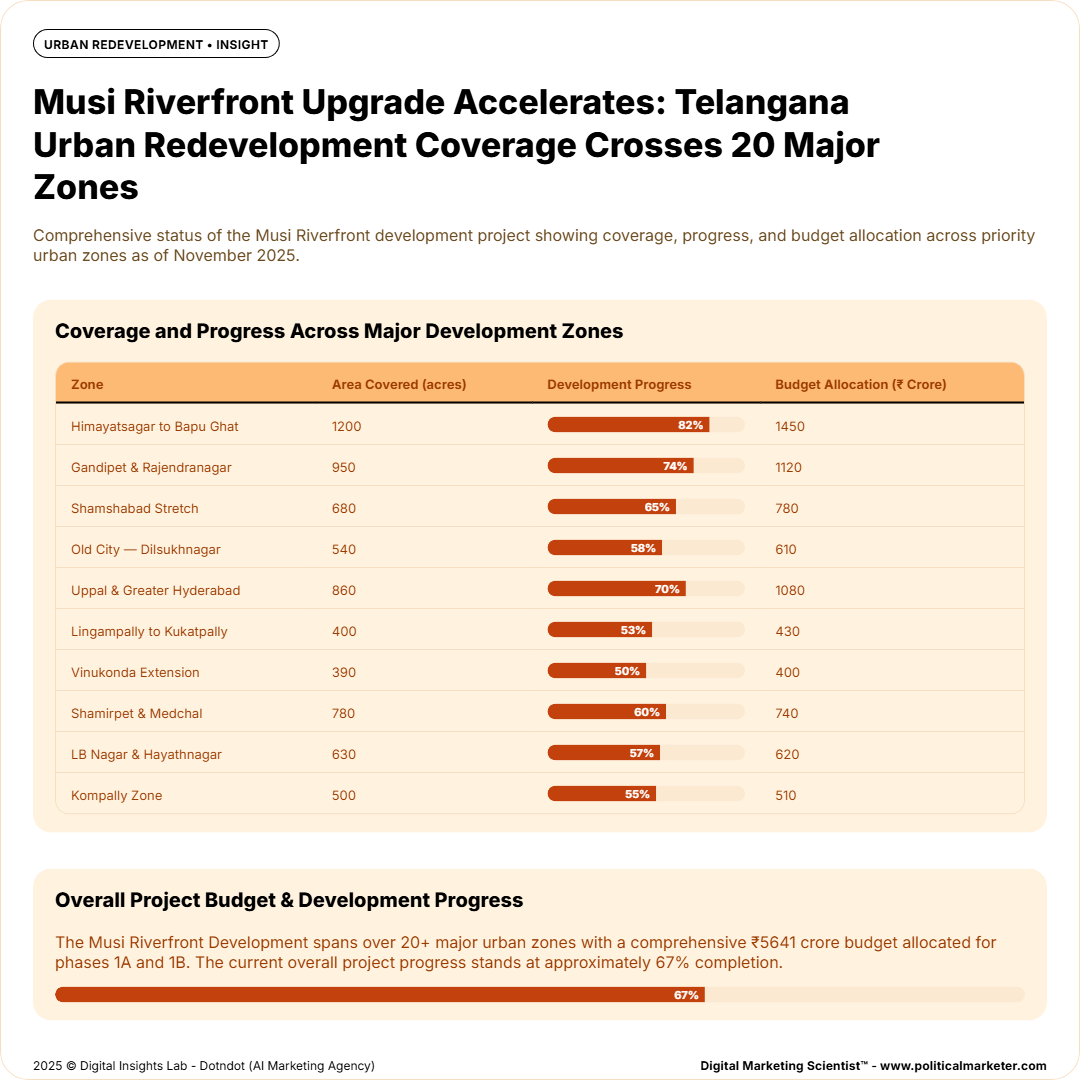
Project Overview
The Musi Riverfront Development Project supports Telangana’s broader plan for urban renewal under the Telangana Rising 2047 Vision Acceleration and Transformation Intelligence framework. You see this project moving the city toward cleaner waterways, safer embankments, and well-planned public zones that support living, recreation, and economic activity.
Scale of the Riverfront
The project covers a 55 km stretch of the Musi River. This corridor forms the backbone of the redevelopment plan and sets the stage for long-term urban transformation across Hyderabad.
Funding Released
The government released ₹375 crore in the second quarter of 2025. This allocation signals the start of structured work on river cleaning, land preparation, and the first set of design and engineering tasks.
Long-Term Vision
The state aims to transform the Musi into a riverfront that matches the quality and urban experience of global examples such as the Thames. The plan aims to restore ecological health while providing continuous public access, mobility infrastructure, and mixed-use development along the river.
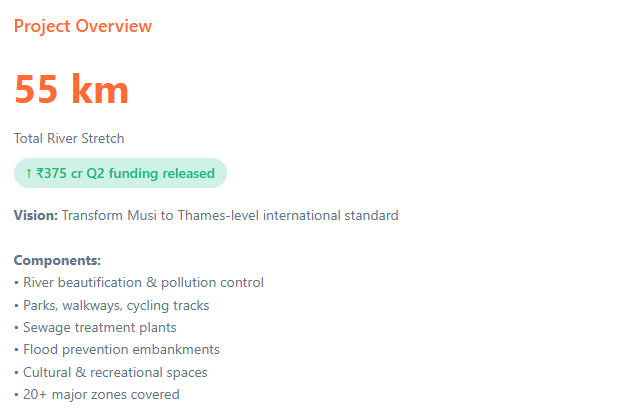
Gateway of Hyderabad – New Iconic Landmarks
Telangana Rising 2047 positions the Gateway of Hyderabad as a signature visual anchor for the next phase of the state’s urban identity. The concept supports the broader transformation agenda by introducing landmark structures that reflect growth, global integration, and advanced urban planning. These assets strengthen the city’s national and international recognition, improve tourism potential, and signal Hyderabad’s long-term shift toward a modern, future-ready metropolitan profile.
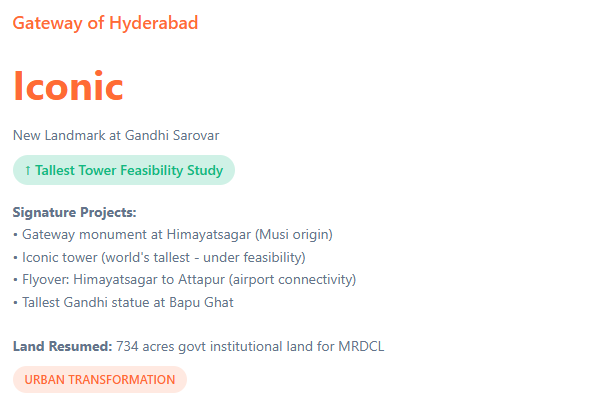
Infrastructure Stress Index and Flood Resilience
This section evaluates how Hyderabad and surrounding regions manage rising pressure on urban systems while preparing for climate-linked risks. It focuses on drainage capacity, stormwater management, land use patterns, and the ability of core infrastructure to withstand extreme rainfall. The assessment highlights areas with recurring overload, identifies high-risk vulnerable zones, and measures the progress of new interventions such as embankments, sewage upgrades, and integrated flood-response planning. The analysis supports the broader 2047 vision by ensuring that rapid urban expansion is matched with resilient, climate-ready infrastructure.
Status Assessment
The Infrastructure Stress Index remains neutral, which means the system requires constant monitoring and regular upgrades. You need consistent intervention to prevent routine stressors from becoming long-term liabilities.
Current Challenge
Hyderabad experiences frequent flooding during moderate rainfall because its road network cannot move water quickly enough. Even 5 centimeters of rain can load several corridors, especially low-lying pockets near natural drainage channels. These areas flood because the current system relies on narrow drains, ageing stormwater lines, and fragmented outflow routes. Rapid urban construction has reduced the amount of open soil available for infiltration, increasing runoff pressure on a system already at capacity.
Drainage Capacity and Structural Gaps
The stormwater network in core urban zones still uses older load estimates that do not reflect current rainfall variability or built-up density. The limited width of primary and secondary drains slows water movement and creates backflow during short, intense spells. You also see frequent blockages because many drains sit below road level and collect debris.
Low-lying and High-risk Zones
Several zones experience recurring flooding because they lie in natural depressions or former lake beds. These areas depend on quick clearance to avoid waterlogging, but the network cannot support that response. As a result, local roads, homes, and small commercial areas can quickly accumulate even with moderate rainfall.
Urban Expansion Pressure
Expansion around the peripheries increases runoff volume, which pushes additional load toward central outflow corridors. The network does not yet keep pace with the growth in paved surfaces, new layouts, and the diversion of natural nullahs.
Implications for 2047 Vision
If this stress continues without structured upgrades, Hyderabad’s economic activity, mobility, and public safety will be repeatedly disrupted during the monsoon.. For Telangana Rising 2047, the city must maintain reliable stormwater and road capacity to support larger population inflows, new economic clusters, and high-density transit corridors.
Strategic Flood Management – Role of Musi Riverfront
The Musi Riverfront project strengthens Hyderabad’s long-term flood resilience by restoring the river’s natural capacity to absorb and move excess water during peak rainfall. The plan expands embankments, clears blocked channels, and builds continuous retention zones along the 55-kilometer stretch.
These upgrades help the city handle intense runoff that overwhelms the current drainage system. The project also reorganizes outflow routes so water reaches the river more quickly, rather than stagnating in low-lying areas.
By combining flood-prevention engineering with new mobility corridors, public spaces, and sewage treatment, the Musi Riverfront becomes a core component of the 2047 resilience strategy. It supports a stable urban system that can manage climate-driven rainfall without disrupting daily activity, economic operations, or mobility across central and eastern Hyderabad.
Integrated Lake and River Network
The plan connects Hussain Sagar, Durgam Cheruvu, Mir Alam, and 182 urban tanks to the Musi main channel. You get a single, continuous water-flow system that moves excess runoff quickly, rather than trapping it in isolated basins. This network restores the city’s historic water circulation pattern, which earlier allowed lakes to balance each other during heavy rain.
Protection for the 55 Kilometer Residential Belt
The project protects the entire 55-kilometer stretch of the residential catchment along the Musi. This stretch includes dense housing clusters that are often flooded by water that overwhelms narrow drains. By widening channels, clearing blockages, and installing controlled outlets, the system provides these neighbourhoods with reliable protection during peak rainfall.
Elimination of Stagnation and Low-Lying Flooding
The current drainage network traps water in low-lying pockets because outflow points are inconsistent and shallow. The upgraded Musi corridor creates a fast, uninterrupted route for stormwater. You get predictable movement of excess water, rather than stagnation that lasts for hours or days. This reduces damage, traffic closure, and waterlogging in commercial and residential zones.
Permanent Solution Instead of Patchwork Repairs
Local repairs, desilting drives, or temporary pumps only offer short relief. The Musi Riverfront introduces a structural solution that removes the root causes of flooding. A stronger river channel, lake connectivity, embankments, and retention zones give the city long-term stability. This approach supports the broader 2047 strategy, which focuses on permanent resilience instead of reactive fixes.
Role in the 2047 Vision
The project aligns with the state’s transformation strategy by providing Hyderabad with a stable hydrological backbone. It reduces risk for housing, mobility corridors, business districts, and public services. By reducing the frequency and impact of urban flooding, the Musi Riverfront enhances the city’s capacity to absorb climate-driven rainfall while maintaining economic and civic continuity.
Recommended Actions
A focused action plan strengthens the 2047 transformation strategy and ensures steady progress across large capital projects. You prioritise quick approvals from global lenders such as JICA, the World Bank, and AIIB to keep long-gestation infrastructure on schedule. You also move private-sector land allocation tied to Summit 2025 agreements to construction-ready status. Positioning Future City against global benchmarks like Jurong in Singapore, DIFC in Dubai, and NEOM in Saudi Arabia sets a clear competitive goal. This approach anchors Telangana’s long-term economic strategy, improves investor confidence, and keeps the state’s flagship projects on a defined acceleration track.
Complete Phase 1 of the Musi Project Before the 2026 Monsoon
You set a clear deadline to finish Phase 1 before the 2026 monsoon cycle. This prevents another season of flooding along the core Musi stretch and demonstrates early progress on the long-term flood-management plan. Finishing this stage on time improves public confidence, reduces annual disruption, and creates room for downstream engineering work that depends on Phase 1 completion.
Implement Smart Drainage Sensors for Real-Time Flood Alerts
You introduce sensor-based monitoring across major nullahs and drainage zones. These sensors give you live data on water levels, blockages, and overflow patterns. You can move emergency teams faster, reduce localised stagnation, and issue warnings early to avoid road closures and damage. This brings Hyderabad closer to a predictive flood-response model rather than the reactive system in place today.
Integrate Climate-Resilient Design into Future City and Metro Infrastructure
You direct all upcoming infrastructure, especially Future City and Metro Phase II-B, to adopt climate-resilient standards. This includes higher embankment protection, stronger stormwater systems, permeable road materials, and evacuation access points. Embedding these elements during construction reduces long-term maintenance costs and protects residents in growth corridors. This approach also ties urban expansion to the larger 2047 resilience framework.
This set of actions strengthens the city’s flood response, protects residents, and keeps all major projects aligned with the 2047 transformation goals.
Rural Digital Infrastructure
Rural digital infrastructure focuses on providing every village with stable broadband, public Wi-Fi access points, and strong mobile connectivity. It supports digital payments, online services, tele-health, and remote learning. This strengthens service delivery, reduces citizens’ travel time, and prepares rural communities to participate in the 2047 economic transition.
Panchayat Digital Connectivity
Panchayat digital connectivity currently stands at 82 percent. Most village offices now use stable internet connections for administrative work, issuing certificates, processing payments, and handling service requests. This improves response time and reduces travel for residents who depend on local governance services.
Broadband Penetration
Broadband access continues to expand across rural areas. More households now use wired or wireless internet for daily needs such as school classes, farm advisory platforms, commerce, and access to public schemes. This growth supports the larger 2047 goal of universal digital access across all villages.
e-Governance Services
More citizens are using online public services for registrations, certificates, utilities, and welfare applications. This shift reduces delays and helps panchayats manage workloads more efficiently. You see wider adoption of digital grievance redressal and transparency dashboards as network reliability improves.
Telemedicine Access
Telemedicine access is rising as more primary health centers adopt digital consultation tools. Rural households now rely on remote medical advice, prescription support, and specialist referrals without having to travel to towns. This strengthens preventive care and links rural patients to district-level health networks.
Integrated View
Together, these components highlight evident progress in rural digital infrastructure. Connectivity, service delivery, and digital health systems continue to improve, helping rural communities participate in Telangana’s long-term transformation strategy for 2047.
Agriculture and Rural Prosperity
Telangana aims to strengthen rural incomes through a mix of modern farming practices, digital access, and market-linked support systems. The state focuses on improving farm productivity, expanding irrigation reliability, and increasing farmers’ access to technology, credit, and extension services. Rising digital connectivity in villages supports wider use of soil data, weather forecasting, and online marketplaces. These shifts help farming households secure better prices, adopt efficient methods, and reduce production risks. Together, these efforts support the broader 2047 vision of a resilient rural economy with stronger livelihoods and balanced regional development.
Sectoral Contribution and Workforce Dependence
Agriculture continues to support a large share of Telangana’s rural workforce, even as the state expands its industrial and services base. Many households still rely on farm income for daily stability, which makes improvements in irrigation, productivity, and market access essential. While the services sector drives most of the state’s GSDP, farming remains central to rural employment and social security. Strengthening this balance is a key part of the 2047 vision, ensuring that growth in advanced sectors does not leave rural communities behind.
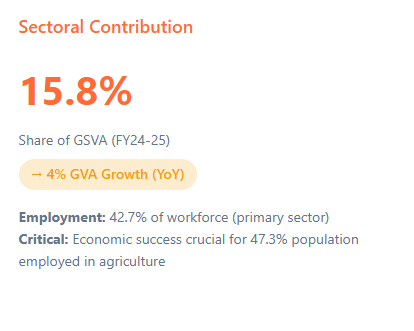
Irrigation Expansion and Water Security
Telangana Rising 2047 places irrigation and long-term water security at the core of rural stability and agricultural growth. The focus is on improving dependable water supply for cultivation, strengthening reservoir networks, and restoring tank systems to support year-round farming. These measures aim to reduce rainfall vulnerability, raise productivity, and secure sustainable livelihoods for the large share of the population dependent on agriculture.

Market Linkage and Digital Agriculture
Telangana Rising 2047 places strong emphasis on creating a modern farm economy supported by digital access, transparent markets, and value-driven supply chains. The focus is on giving farmers direct connections to buyers, expanding digital platforms for crop pricing and payments, and improving access to storage, logistics, and processing facilities. These efforts aim to raise farm incomes, reduce market inefficiencies, and integrate rural producers into high-value agri-business networks.
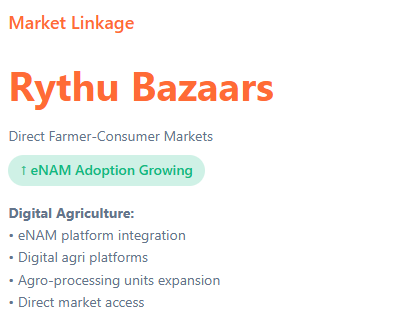
Farmer Prosperity and Women–Farmer–Youth Club Model
The model strengthens rural growth by bringing farmers, women’s groups, and young workers into a single development network. It improves knowledge sharing, expands access to credit, increases digital participation, and supports new income streams in agriculture and allied sectors. This collective structure encourages community-level problem solving, faster adoption of modern practices, and stronger market connections. It serves as a core pillar of Telangana Rising 2047 by linking rural prosperity with human capital development and long-term economic stability.
Integrated Prosperity Framework
The framework connects agriculture, rural enterprise, digital infrastructure, and community development into a unified growth model. It links farm productivity to market access, supports women’s and youth’s participation, and strengthens local economic activity through coordinated institutional systems. By combining irrigation upgrades, digital services, skill development, and modern market linkages, the framework ensures balanced growth between rural and urban regions. It reinforces the Telangana Rising 2047 vision by positioning rural prosperity as a core driver of the state’s long-term economic and social transformation.
Income Enhancement
The framework improves rural incomes through targeted interventions. Crop diversification helps farmers shift from low-return crops to higher-value options. Direct market linkage removes intermediaries and enables higher value addition. Expansion of agro-processing units increases local value addition and strengthens rural enterprises. These steps work together to build a stable and higher-earning farm economy.
Risk Mitigation
The model reduces farmer vulnerability by expanding insurance coverage and promoting climate-resilient practices. Insurance reduces income shocks during crop loss. Climate-resilient methods strengthen long-term farm stability by improving soil health, adapting irrigation practices, and preparing farmers for erratic rainfall. Together, these measures strengthen the rural safety net.
Resource Access
The framework improves access to essential inputs and services. Irrigation upgrades expand water availability across districts. Credit support gives farmers reliable financing for seeds, equipment, and diversification. Digital platforms provide market information, farm advisories, weather alerts, and price trends, helping farmers make informed decisions. These tools create a more structured and predictable production environment.
Women–Farmer–Youth Club
This component integrates women, farmers, and youth into a coordinated rural development model. It supports women through training and income-generation programs. It strengthens farmer-led growth through collective problem-solving and shared resource planning. It encourages youth entrepreneurship by linking skill development with local economic opportunities. This combined structure creates a rural ecosystem where productivity, skills, and enterprise grow together.
Alignment with Vision 2047
The framework supports long-term rural transformation by strengthening income growth, reducing production risks, and improving access to essential resources. It connects women, farmers, and youth through an integrated model that supports skills, enterprise, and community-led progress. These elements help build a stable rural economy that contributes directly to Telangana’s Vision 2047 goals of higher productivity, inclusive growth, and balanced development across districts.
Recommended Actions
Strengthen rural income systems, digital access, and irrigation reliability to support long-term agricultural growth that fits Vision 2047. Expand market linkages, processing units, and direct sales platforms to improve farmer earnings. Improve climate resilience through water management upgrades, insurance coverage, and broader use of digital advisory tools. Support women, farmer groups, and youth-led initiatives to build a balanced rural economy that contributes to the 3T vision.
Expand Women–Farmer–Youth Clubs
You need full coverage of these clubs in every gram panchayat by 2026. This step creates a consistent platform for skill training, income generation, and community coordination. It also builds a structured network for local problem-solving and shared resources across villages.
Integrate AI Advisory Systems
AI tools for crop guidance and weather prediction improve planning and reduce losses. These tools support farmers with timely alerts, crop recommendations, soil insights, and risk detection. When you integrate them at scale, you strengthen productivity and reduce exposure to climate shocks.
Link FPOs to Future City Processing Clusters
Connect Farmer-Producer Organizations to processing hubs planned under the Future City vision. This link converts raw produce into higher-value goods, expands income opportunities, and reduces wastage. It also supports formal market participation and enhances farmers’ bargaining power.
Strengthen Digital Literacy for Market Access
Train farmers to use digital tools for buying inputs, comparing prices, and selling produce online. Increased digital familiarity helps them track market trends, access advisory services, and participate in online marketplaces with confidence. This step supports wider adoption of digital agriculture platforms and ensures equal access across rural communities.
Farmer Prosperity Index – Key Components
The Farmer Prosperity Index measures how rural households progress across income, productivity, and quality-of-life indicators that matter to Vision 2047. It tracks shifts in farm earnings, crop diversity, market participation, and access to modern tools. It also captures non-income factors such as risk protection, irrigation reliability, digital access, and the strength of farmer networks. By combining economic, environmental, and social metrics, the index gives you a structured way to evaluate how rural communities advance and how policy decisions translate into real improvements on the ground.
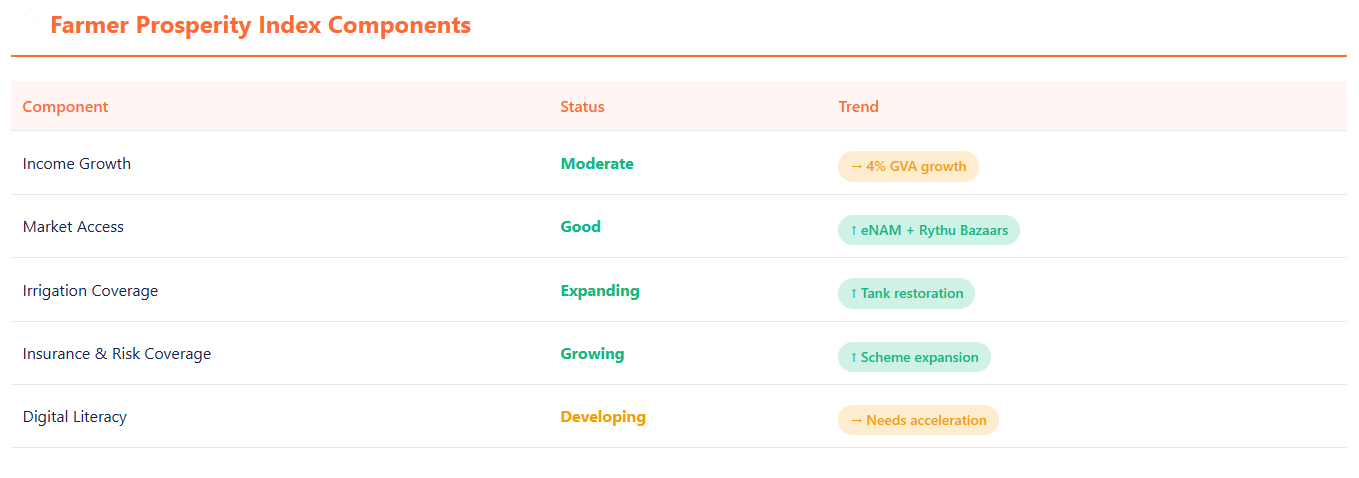
Water Resource Monitoring and Climate Intelligence
Water resource monitoring and climate intelligence focus on building a reliable, data-driven system that improves Telangana’s management of rainfall, groundwater, reservoirs, tanks, and agricultural water needs. The approach supports Vision 2047 by combining real-time tracking, predictive insights, and district-level planning. It strengthens irrigation outcomes, improves drought and flood preparedness, and ensures that farmers and local administrations respond faster to weather shifts and water stress.
Seasonal Monitoring
You track Kharif and Rabi patterns throughout the year to understand rainfall distribution, crop water needs, and irrigation demand cycles. This consistent tracking helps you see shifts in sowing behaviour, rainfall irregularities, and seasonal stress points across districts.
Groundwater and Water Table Alerts
You monitor water table levels to identify early signs of stress. Regular groundwater readings support district administrations and farmers by showing when recharge slows down or when extraction rises. This gives enough lead time to plan rationing, micro-irrigation, or alternative cropping patterns.
Predictive Yield Models
AI-driven yield models project production patterns up to 2047. These models use rainfall, soil moisture, groundwater, crop health data, and historic yield trends. They help you estimate shifts in output, district-level variations, and long-term supply risk for major crops.
Real-Time Risk Alerts
The system issues immediate alerts for districts and mandals facing water-related risks. The alerts cover three categories:
Drought-Prone Zones
The system identifies rainfall deviation, negative soil moisture trends, and fast groundwater depletion. You receive alerts when a district begins to experience water stress.
Stress Areas
You get warnings for regions that show slow tank recharge, irregular canal flows, or below-normal reservoir levels. These alerts help local teams respond early.
Low Irrigation Coverage
Districts with limited irrigation access are tracked continuously. The system sends alerts when rainfall deficiency or canal supply issues increase the vulnerability of these regions.
Integration with Vision 2047
This monitoring framework supports Telangana Rising 2047 by creating a statewide climate intelligence layer. It strengthens food security, improves irrigation planning, reduces crop losses, and enables administrators to respond more quickly to seasonal changes—the system also lays he foundation for future investments in irrigation, groundwater recharge, and climate-resilient agriculture.
Sustainability and Climate Resilience
Telangana Rising 2047 positions sustainability and climate resilience as core priorities for long-term rural and urban stability. The focus is on strengthening water security, promoting climate-smart agriculture, and expanding digital climate intelligence across districts. Seasonal water tracking, groundwater monitoring, and AI-based yield models help you respond faster to stress zones and drought-prone areas. These efforts support reliable irrigation, reduce climate-related losses, and improve planning for future infrastructure. This framework ensures that Telangana maintains steady agricultural output, protects vulnerable communities, and builds a resilient foundation for the 3T vision.
Net Zero Telangana 2047 – Renewable Energy Leadership
Telangana Rising 2047 sets a clear direction to position the state as a national leader in clean energy and carbon neutrality. The focus is on expanding solar and wind capacity, strengthening decentralized energy systems, and integrating renewable power into large industrial and urban projects. Grid modernization, storage solutions, and the adoption of electric mobility support this transition. These measures help you reduce long-term energy costs, cut emissions, and build a stable power ecosystem that supports the 3T economy, Future City developments, and climate resilience goals.
Telangana positions itself as a national leader in clean energy through clear goals, consistent growth in renewable capacity, and continued investment in low-carbon systems. The state’s progress supports the broader Vision 2047 agenda that focuses on long-term sustainability, reduced fossil fuel dependence, and integrated energy planning for urban and rural regions.
Growing Renewable Energy Base
Telangana expands solar power generation across districts, supported by large utility-scale plants and increased rooftop adoption. Wind and hybrid systems add diversity to the grid. These additions help you reduce pressure on conventional power sources and stabilise supply during peak demand cycles.
Grid Modernisation and Storage
The state improves grid reliability through upgraded transmission corridors, smart metering, and energy storage pilots. These improvements support variable renewable supply and prepare the system for future industrial and residential demand linked to Future City and other high-growth zones.
Decentralised and Rural Energy Systems
Localised solar plants, agricultural solar pumps, and microgrids strengthen energy access in rural regions. These systems reduce reliance on diesel backup power and help farmers manage energy costs more effectively.
Integration with Economic Growth
Renewable energy expansion supports the 3T economy by lowering operational costs for industries, creating new green jobs, and enabling climate-resilient infrastructure. Clean power integration also strengthens the environmental baseline for large projects, including industrial corridors and food processing clusters.
Alignment with Net Zero Goals
The state’s approach supports long-term carbon neutrality by reducing coal use, increasing the adoption of electric mobility, and improving energy efficiency across urban and rural services. You get a long-term framework that strengthens energy security and supports sustainable growth across districts.
Ambitious Renewable Energy Targets (Telangana Green Energy Policy 2025)
Telangana sets clear and aggressive renewable energy goals that support Vision 2047 and the long-term shift to a low-carbon economy. The Green Energy Policy 2025 outlines accelerated growth in solar, wind, hybrid, and storage capacity, ensuring the state builds a resilient, future-ready power ecosystem. These targets strengthen energy security, reduce dependence on thermal sources, and position Telangana as a major contributor to India’s clean energy transition.
Vision for 2034–35
Telangana sets clear capacity goals for solar, wind, and storage to build a resilient, low-carbon power system. The state plans to reach 26,374 MW of solar and 4,528 MW of wind. It also targets 5,450 MW of battery storage to stabilise the grid and support peak demand. These goals strengthen long-term energy security and support steady industrial expansion.
Transition to Clean Power by 2030
The policy sets a target of 20,000 MW of renewable energy and storage by 2030. Telangana plans to derive half of its electricity from non-fossil sources by 2030, which matches India’s national commitment. This shift reduces dependence on thermal power and positions the state for sustained decarbonisation through 2047.
Current Progress and Large-Scale Projects
The state has already installed more than 6,500 MW of renewable capacity. The Kakatiya Mega Solar Park, with 1,000 MW of solar generation capacity, is one of India’s most significant operational solar clusters. It lays a strong foundation for future expansion and demonstrates the state’s ability to rapidly scale renewable infrastructure.
Strategic Importance to Vision 2047
These targets support Telangana Rising 2047 by expanding access to clean energy, reducing long-term power costs, strengthening climate resilience, and enabling future industries to grow on a stable, sustainable electric grid.
Recommend Climate Actions..
Telangana Rising 2047 positions climate stability as a core requirement for long-term growth. The state focuses on reducing emissions, improving renewable adoption, strengthening water security, and expanding climate-ready infrastructure. These actions support a steady transition toward a low-carbon economy and ensure that agriculture, industry, and urban regions remain resilient through 2047.
This section outlines how Telangana can strengthen its climate strategy under Vision 2047 by expanding renewable capacity, building net-zero zones, scaling green hydrogen, and attracting global climate finance. Each action strengthens long-term energy security and supports the state’s transition to a low-carbon economy.
Accelerate Wind–Solar Hybrid Parks
You expand hybrid parks to improve reliability and grid stability. These parks combine wind and solar to provide continuous generation, reduce variability, and support large battery storage clusters. This also helps Telangana reduce dependence on fossil-based peak power.
Develop Future City as a 100 Percent Renewable Net-Zero Economic Zone
Future City becomes India’s first economic zone that operates entirely on renewable energy. You integrate green buildings, electric mobility, storage systems, and digital energy management. This zone sets the long-term model for net-zero districts and attracts investors seeking low-carbon industrial spaces.
Launch Large-Scale Green Hydrogen Production
You deploy green hydrogen production units by using surplus solar and wind energy. These units support sectors like mobility, fertilizers, and heavy industries. Telangana positions itself early in the national hydrogen market and builds export-oriented capabilities.
Secure Global Climate Finance Partnerships
You engage with international climate funds, development banks, and clean-energy investors. These partnerships support renewable expansion, storage development, hydrogen projects, and climate-resilient urban infrastructure. Access to concessional finance reduces project costs and accelerates statewide transition.
This combined approach supports Telangana Rising 2047 by strengthening energy independence, lowering emissions, and preparing economic zones, industries, and communities for a climate-secure future.
Renewable Energy Capacity
Telangana’s renewable energy expansion supports the broader Vision 2047 framework by strengthening energy independence, stabilizing power supply, and preparing the state for a net-zero transition. The current portfolio combines solar, wind, and storage assets, with large-scale additions planned under the Green Energy Policy 2025. With more than 6,500 MW already installed and major projects such as the Kakatiya Mega Solar Park in operation, the state is moving toward its targets for 2030 and 2034–35. This growth positions Telangana as a leading contributor to India’s non-fossil energy goals and lays the foundation for future hydrogen production, net-zero districts, and climate-resilient infrastructure.
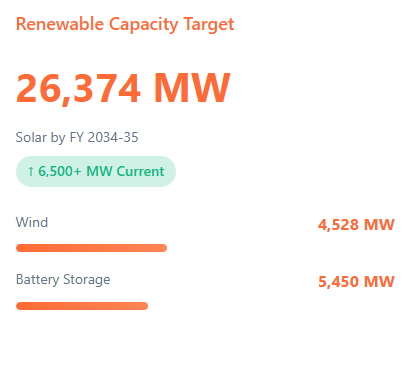
Forest Cover & Ecological Assets
Telangana Rising 2047 emphasizes environmental restoration as a core pillar of long-term resilience. Forest cover, green assets, and protected ecosystems form the natural backbone that supports climate stability, water security, and sustainable urban growth. Strengthening these ecological systems ensures that rising economic activity aligns with long-term environmental health while safeguarding biodiversity and community well-being.
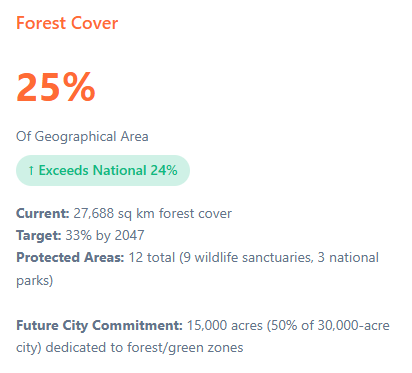
Green Hydrogen Pioneer
Telangana positions itself as an early leader in India’s green hydrogen transition. The state links renewable energy capacity, emerging hydrogen pilots, and future industrial demand to build a clean production ecosystem that supports Vision 2047. This direction strengthens long-term energy security, reduces dependence on fossil inputs, and prepares key sectors such as mobility, manufacturing, and heavy industry for low-carbon growth.
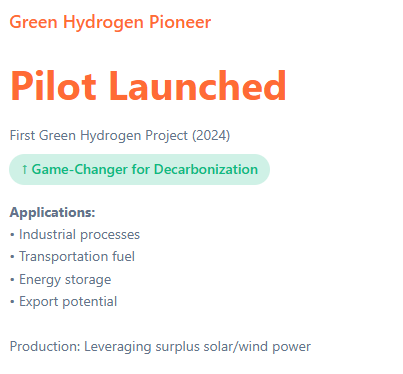
Carbon Neutrality Pathway (2025 to 2047)
Telangana’s carbon-neutrality pathway sets a structured transition from incremental reductions in 2025 to full net-zero by 2047. The state focuses on large-scale renewable expansion, green hydrogen deployment, energy-efficient urban systems, and nature-based solutions. This pathway links economic growth with climate responsibility and positions the state to lead India’s long-term low-carbon transformation under Vision 2047.
2025 Baseline
The pathway begins with a precise measurement of Telangana’s starting position. The state operates with more than 6,500 megawatts of renewable energy, a 25 percent forest cover, and an emissions baseline to track long-term reductions. These benchmarks serve as a reference point for future planning and allow you to monitor annual progress toward net zero.
2030 Milestone 1
By 2030, the state will reach a combined renewable and storage capacity of 20,000 megawatts. Half of its electricity generation comes from non-fossil sources. Green hydrogen reaches full operational status and is ready for industrial use. Electric vehicles see mass adoption in public and private transport, lowering emissions in urban and rural areas.
2035 Milestone 2
By 2035, Telangana will expand its renewable energy base to 26,374 megawatts of solar and 4,528 megawatts of wind power. Renewables form 70 percent of the total power mix. Future City transitions to complete net-zero operations, using clean energy, efficient systems, and low-emission infrastructure to support long-term sustainability.
2047 Net Zero Telangana
By 2047, the state meets its 100 percent renewable electricity target. Forest cover reaches 33 percent through sustained conservation and afforestation. Telangana moves into a carbon-neutral economic model that supports growth without rising emissions. The green hydrogen sector scales further, and the state positions itself as an export hub for the Asia Pacific and Middle East regions.
Climate Risk and Air Quality Management
Telangana Rising 2047 places climate safety and clean air at the center of long-term planning. The state adopts data-driven climate risk systems that track heat, rainfall variability, and extreme weather patterns. Air quality management shifts from reactive response to continuous monitoring, early alerts, and targeted action in urban and rural zones. This approach strengthens public health, supports sustainable growth, and ensures that climate and air quality decisions stay integrated with the broader goals of Vision Acceleration and Transformation Intelligence.
District Climate Risk Map, 2025
Telangana’s climate risk profile shows apparent regional variations that influence planning, infrastructure design, and emergency preparedness. Hyderabad continues to face flooding, especially in its low-lying areas. Khammam reports similar exposure due to heavy seasonal inflows. In contrast, Mahabubnagar and Nalgonda record persistent drought patterns driven by rainfall gaps and groundwater decline. Hyderabad also experiences growing heat stress as urban heat island effects intensify due to rapid construction and reduced surface ventilation.
Key Climate Risks by Zone
Flood-Prone Locations
Hyderabad’s low-lying areas and parts of Khammam remain vulnerable during heavy rainfall events. These zones require continuous drainage upgrades, catchment redesign, and hydrological monitoring to prevent repeated inundation.
Drought Hotspots
Mahabubnagar and Nalgonda continue to face dry spells and groundwater depletion. These districts need sustained irrigation support, crop planning inputs, and long-term water balance management.
Heat Wave Intensification
Hyderabad’s urban core records higher surface temperatures than its peri-urban and rural surroundings. Limited tree cover and high-density construction contribute to rising heat retention.
Mitigation Strategies
Musi Riverfront Project for Flood Management
The redesign of the Musi Riverfront strengthens flood control by widening channels, restoring flow paths, and improving stormwater outlets. This reduces the frequency and severity of urban flooding in Hyderabad.
Afforestation for Heat Reduction
Large-scale tree planting in urban and semi-urban areas helps reduce surface temperatures and improve local air quality. Priority zones include traffic corridors, residential clusters, and heat-intensive commercial districts.
Irrigation Expansion for Drought Resilience
New irrigation networks and restored tanks expand water availability in drought-hit regions such as Mahabubnagar and Nalgonda. These interventions support crop stability, reduce seasonal migration, and improve groundwater recharge.
Integration with Vision Acceleration and Transformation Intelligence
The state uses climate data, satellite-fed risk layers, and district-level alerts to guide planning decisions. This system links climate intelligence with infrastructure, agriculture, and air quality programs. It supports proactive action rather than reactive response and strengthens the long-term goal of building a climate-resilient Telangana by 2047.
Air and Water Quality Monitoring
Telangana is strengthening continuous monitoring systems to track pollution levels, detect risks early, and support data-driven environmental decisions. The state uses real-time air quality stations, water sampling networks, and automated sensors across key districts to measure particulate emissions, industrial discharge, groundwater quality, and surface water health. This monitoring framework offers accurate visibility into contamination sources and helps you act before environmental stress becomes severe. It also supports long-term planning for cleaner cities, protected water bodies, and healthier rural ecosystems as part of the broader Vision 2047 transformation agenda.
Real-time Air Quality Tracking
Telangana uses continuous air quality monitoring across all major cities to measure particulate matter, gaseous pollutants, and overall AQI. You get real-time visibility into pollution trends, seasonal variations, and urban hotspots. This system helps you act early when emissions rise and allows local bodies to build targeted clean-air responses for transport, industry, and construction-related pollution.
River Basin Quality Mapping
The state monitors water quality across the Krishna, Godavari, and Musi basins. This includes tracking chemical discharge, organic load, and contamination sources. These datasets help you understand basin-level stress, pollution clusters, and the health of river-dependent settlements. They are also essential for long-term planning for ecological recovery and improved flow conditions.
Lake Revitalization Programs
Telangana runs structured pollution-reduction programs for major lakes such as Hussain Sagar and Durgam Cheruvu. These programs include sewage diversion, desilting, nutrient load reduction, and checks on industrial discharges. They also support urban cooling, biodiversity recovery, and improved water retention. You get measurable improvements in clarity, odor reduction, and overall lake health.
Integrated Water Body Connectivity Goal
The long-term goal is to connect all lakes, tanks, and urban water bodies to the Musi drainage network. This improves flood control by allowing controlled water flow during high rainfall events. It also enables systematic wastewater treatment and ecological regeneration. The plan reduces local flooding, supports stable groundwater levels, and restores natural water pathways that have degraded over time.
Expanded Environmental Intelligence for 2047
Air and water monitoring systems are part of the broader Vision 2047 strategy. They provide the data backbone for early warnings, pollution enforcement, sustainable city planning, lake recovery, and river rejuvenation. By combining continuous monitoring with improved drainage design and pollution control, Telangana builds a more resilient environmental framework for its growing population and urban centers.
Circular Economy and Waste Management
Telangana Rising 2047 places circular systems at the center of its environmental strategy. The focus is on reducing waste generation, improving recovery rates, and building closed-loop processes across urban and rural areas. The state moves from a disposal-focused model to one that prioritizes reuse, recycling, and resource efficiency. City corporations expand door-to-door segregation, material recovery facilities, and decentralized composting units. Rural blocks adopt similar systems through panchayat-level waste clusters and village sanitation hubs.
The program also promotes cleaner production in industries, extended producer responsibility for plastics, and organized recycling networks connected to digital tracking platforms. These measures support better air quality, lower landfill use, and stronger climate outcomes. Together, they build a resilient, resource-efficient system that aligns with Telangana Rising 2047’s long-term goals.
Waste to Energy
Telangana strengthens its circular economy plan by expanding waste-to-energy systems that process 1,200 tons of solid waste each day. These plants convert urban solid waste into power, reduce landfill pressure, and support cleaner city operations. The model generates a steady stream of energy while managing waste at scale, serving as a foundational pillar for long-term resource recovery.
Biomass and Agricultural Residue Energy
The state advances biomass and agricultural residue energy projects that convert crop waste into usable power. These projects reduce open-field burning, improve rural air quality, and create new income streams for farmers. You see a shift toward organized networks for network collection, pelletization units, and district-level processing centers that feed into local and industrial power systems.
Urban Circular Economy Systems
Cities expand segregation, recycling, and material recovery operations to reach higher efficiency. Municipal systems now stress source-level segregation, neighborhood collection grids, and recycling workflows that feed into formal processing units. Innovative tracking tools support these operations with route optimization, load monitoring, and data dashboards that help cities manage waste with better accuracy.
Smart Waste Collection
Digital systems improve pickup timing, vehicle routing, and coordination among processing centers. These tools reduce missed pickups, fuel use, and operational delays. You get cleaner streets and more predictable waste flows into processing units.
Electric Vehicle Charging Infrastructure
The state accelerates the installation of EV charging stations across highways, city centers, and Future City zones. These stations support public transport, private EV users, and commercial fleets. This expansion helps reduce fossil fuel use and lays the mobility foundation for Telangana’s broader carbon-neutrality pathway.
Integrated Circular Economy Outlook
Together, waste-to-energy plants, biomass conversion systems, improved recycling, and widespread EV charging form a resource-efficient system that reduces pollution, increases energy availability, and supports long-term climate targets. Telangana Rising 2047 uses these components to build a cleaner, low-carbon, and digitally managed circular economy.
Governance, Digital Transformation, and Public Services
Telangana strengthens governance through a data-first and technology-driven public service model. The state moves toward unified digital platforms that simplify citizen services, improve transparency, and reduce administrative delays.
Real-time dashboards track welfare delivery, infrastructure progress, climate indicators, and district development metrics, giving administrators faster decision-making tools. Public service centers move toward full digital integration, enabling predictable service delivery across urban and rural areas.
These reforms support a governance system that is faster, more accessible, and equipped to manage long-term development under the Telangana Rising 2047 framework.
Fiscal Strength and Autonomy
Telangana focuses on building a resilient fiscal base that supports long-term development without overdependence on external borrowings. The state strengthens revenue generation by diversifying sectors and advancing priorities in infrastructure, climate resilience, digital transformation, and social welfare. Strategic financial planning, disciplined debt management, and targeted investment frameworks improve fiscal room for significant 2047 commitments. This approach enhances autonomy, supports stable growth, and ensures sustained funding for large-scale transformation projects across districts.
Own Tax Revenue Share
Telangana generates 88 percent of its revenue from its own tax sources. This is the highest share among Indian states and shows that the state relies more on internal revenue than on central transfers.
What This Signals
A strong own-tax base gives Telangana significant fiscal independence. You see this when the state funds major development programs without waiting for additional central support. This independence reduces exposure to external funding delays and allows consistent execution of medium and long-term commitments.
Why It Matters for Vision 2047
High fiscal autonomy enables Telangana to plan and implement a long-term transformation strategy. The state can direct resources toward infrastructure, climate programs, technology upgrades, Future City, rural development, and social protection without significant funding constraints. This financial stability strengthens the foundation needed to reach the 2047 goals and supports continuous investment across districts.
This structure ensures that Telangana enters the next two decades with a stable revenue base, control over priorities, and the capacity to execute a self-driven development agenda.
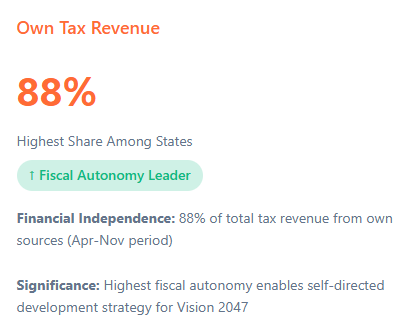
Digital Governance and Citizen Service Delivery
Telangana continues to expand its digital governance systems, improving how people access public services. The focus is on quick delivery, minimal paperwork, and easy digital access. Platforms for certificates, social welfare, land records, and grievance redressal now operate through integrated digital workflows. District offices use real-time dashboards to track service requests, reduce delays, and improve accountability.
As the state moves toward Vision 2047, digital systems aim to cover every major public service. The goal is to ensure that residents can complete essential tasks online, track applications in real time, and receive predictable service outcomes. This approach strengthens transparency, lowers administrative burden, and supports consistent service delivery across rural and urban areas.
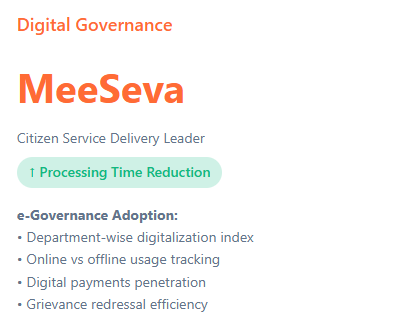
Budget Execution and Public Accountability
Telangana’s approach to budget execution focuses on timely fund release, strict expenditure tracking, and transparent disclosure of spending outcomes. The state links departmental performance metrics with financial allocation to ensure that funds reach priority programs without delay. Public dashboards, audit trails, and digital reporting tools improve accountability and help residents track how money is spent across sectors. This transparency supports the broader Vision 2047 objective of building a predictable, efficient, and citizen-facing fiscal system that strengthens trust and enables long-term development planning.

Future-Ready Governance, AI Mission and Global Partnerships
Telangana is advancing a governance model that integrates AI-driven public systems with strategic international collaborations. The state is building AI tools for service delivery, predictive administration, climate readiness, resource optimisation, and citizen support. At the same time, it is forming global partnerships with technology leaders, investment agencies, and research networks to bring advanced solutions, capital, and talent into government programs. This combined approach strengthens administrative capacity, attracts new economic opportunities, and supports the long-term aims of Telangana Rising 2047.
Telangana AI Mission (in partnership with NASSCOM)
The Telangana AI Mission, created in partnership with NASSCOM, is building a strong foundation for state-wide AI adoption that supports the long-term goals of Telangana Rising 2047. The program strengthens AI innovation, promotes applied research, and expands AI-focused startups. It also helps government departments use AI for planning, service delivery, and decision support. By connecting the state to national and global AI ecosystems, the mission positions Telangana as a leading hub for responsible, high-impact AI development.
AI Framework Implementation
The Telangana AI Mission uses a Responsible AI framework that sets rules for ethical use and prevents misuse across public systems. This framework guides model deployment, data handling, and safeguards that protect citizens while supporting high-impact AI adoption across departments.
Centres of Excellence
The mission runs Centres of Excellence that partner with the foremost private-sector technology leaders. These centres help the state test advanced AI tools, accelerate research, and develop applied solutions for real-world governance needs. They also serve as training hubs for startups and innovators developing AI-driven products.
J-PAL AI Research Lab
The state works with the Abdul Latif Jameel Poverty Action Lab to operate an AI Research Lab focused on public welfare. The lab studies how AI can improve the delivery of social programs, strengthen monitoring systems, and support more accurate decision-making for targeted benefits.
Governance Applications
Telangana applies AI across several layers of government functions.
Predictive analytics improves planning for health, agriculture, infrastructure, and disaster response.
Automated workflows reduce processing delays, cut paperwork, and help departments handle large volumes of citizen requests.
Citizen service improvements come from AI-powered support systems, faster grievance resolution, and real-time tracking dashboards that monitor service quality.
Impact
The Telangana AI Mission supports skill development for 2.5 lakh students and professionals. It expands AI literacy, strengthens the talent pipeline, and equips the workforce to participate in the state’s long-term Vision 2047 transformation goals.
Role of Embassies and Consulates (Economic Diplomacy)
Telangana uses its partnerships with embassies and consulates to expand global engagement and secure long-term economic advantages. These partnerships help the state identify foreign investment opportunities, connect with international companies, and promote its strengths in technology, manufacturing, agriculture, and clean energy. They also support trade missions, skill development linkages, and joint innovation programs. This approach strengthens Telangana Rising 2047’s international footprint and builds stronger global networks for investment, research, and market access.
Investment Facilitation Through Embassies
Telangana uses its embassy network to strengthen global investment outreach. These missions help the state identify potential investors, share sector-focused information, and build long-term economic relationships. They also serve as a direct link between Telangana and international companies seeking opportunities in technology, life sciences, clean energy, food processing, and advanced manufacturing.
Coordination of Foreign Delegations for Global Summit 2025
Embassies support the state by coordinating high-level delegations for the Telangana Global Summit 2025. Their role includes scheduling meetings, screening delegations, and ensuring that visiting governments and companies engage with the right partners. This strengthens the summit’s position as a global business event connected to Vision 2047.
Cultural Diplomacy Through International Events
Consulates and embassies help Telangana take part in cultural and academic exchanges. These events promote the state’s identity, heritage, and creative sectors. They also expand outreach to diaspora communities and global networks that support tourism, trade, and knowledge partnerships.
Strengthening the Local to Global Strategic Model
Embassy-led engagement helps Telangana extend its economic narrative from local sectors to global markets. This outreach supports the state’s long-term strategy to grow high-value exports, attract capital, and establish the Future City region as a global economic hub.
Deploy AI-Powered Grievance Prediction
Use predictive analytics to identify and resolve investor issues early. This reduces delays, strengthens confidence, and improves Telangana’s reputation as a reliable investment destination.
Set Up Telangana Investment Desks in 20 Key Embassies by Q2 2026
Create dedicated investment desks in priority global embassies. These desks can provide real-time information, address regulatory queries, and serve as permanent points of contact for interested parties in Telangana.
Create an AI Ethics Board With J-PAL
Work with J-PAL to establish an AI Ethics Board to oversee responsible AI adoption across government and the private sector. This framework ensures transparency, prevents misuse, and strengthens public trust in AI-driven public services.
Government–Industry Dialogue
A structured coordination system connects Telangana’s government departments with leaders from technology, manufacturing, clean energy, agriculture, logistics, and services. This dialogue strengthens policy clarity, accelerates sector-level reforms, and ensures faster execution of investment commitments. The approach also supports Vision 2047 by aligning industry needs with long-term goals in innovation, renewable energy, employment generation, and global competitiveness.
Industry Body Partnerships
Telangana works closely with major industry bodies to accelerate economic growth and strengthen its Vision 2047 goals. Partnerships with groups such as CII, FICCI, NASSCOM, and sector-specific associations support policy design, skill development, and technology adoption. These collaborations help the state identify emerging trends, improve investment readiness, and connect local enterprises with national and global opportunities.
Telangana strengthens its Vision 2047 goals through structured partnerships with leading industry bodies. These partnerships support policy development, investment growth, sector expansion, and coordination between government and industry. Each body contributes through its core strengths, and the state uses regular engagement channels to maintain continuity and clarity.
Strategic Partners and Their Roles
ASSOCHAM (Policy Dialogue and Sector Analysis)
ASSOCHAM provides support, offers recommendations, and conducts sector-specific assessments. This is in response to the statement, which includes research on emerging markets, industry bottlenecks, and regulatory needs. The insights help you refine long-term economic and industrial strategies.
CII (Investment and Global Outreach)
CII assists Telangana in attracting investments and expanding its global footprint. The partnership supports investor meetings, trade interactions, and engagement with international business forums. This strengthens the state’s position as a preferred investment destination.
FICCI (Manufacturing and MSME Engagement)
FICCI works with manufacturing and MSME clusters, helping the state identify operational gaps, credit access issues, and export-readiness. Joint programs support new technology adoption, process modernization, and sector benchmarking.
NASSCOM (IT and AI Ecosystem Support)
NASSCOM contributes to the growth of the IT and AI ecosystem. The partnership supports skill development, digital innovation programs, and the growth of early-stage AI startups. It also supports the Telangana AI Mission through dialogue with global technology leaders.
CREDAI (Real Estate and Future City Development)
CREDAI’s role focuses on real estate development, regulatory reform, and the Future City program. The partnership supports planning standards, sustainable infrastructure, and industry feedback for urban design and housing policies.
Mechanism of Engagement
The state maintains regular communication with each industry body through townhalls, consultations, and expert Q&A sessions. These interactions help you identify operational issues, understand industry feedback, and quickly refine policies. The process supports continuous improvement across sectors and ensures that private-sector perspectives remain part of the Vision 2047 transformation agenda.
Global Consulting Ecosystem
Telangana engages a vast network of global consulting firms to support its long-term Vision 2047 strategy. Their expertise strengthens policy design, infrastructure planning, digital transformation, and investment outreach. This ecosystem helps the state validate reforms, benchmark global best practices, and accelerate implementation across key sectors. Through structured collaboration, Telangana gains access to advanced analytics, project evaluation frameworks, and international development models that support sustained economic growth and institutional efficiency.
Ecosystem Partners
You have four primary categories of consulting partners, each supporting different parts of the transformation agenda.
Strategy and Policy Advisory
EY, PwC, Deloitte, and KPMG support strategy development, due diligence, and policy reviews. Their analysis strengthens government decision-making, especially for large projects that require independent evaluation or multi-year financial planning.
Real Estate and Future City Intelligence
Knight Frank, CBRE, and JLL provide market research, planning insights, and feasibility studies for the Future City framework. Their inputs help the state benchmark global standards for urban planning, land optimization, commercial corridors, and infrastructure phasing.
Role in Vision 2047
These firms contribute to the state’s long-term objectives in several ways.
Knowledge Partners for Global Summit 2025
They prepare market intelligence, investment briefs, and sector reports that support the Global Summit’s outreach to foreign investors and global companies. Their work strengthens Telangana’s credibility on the international stage.
Investor Confidence Building
Third-party validation of policies, investment proposals, and infrastructure plans increases trust among domestic and global investors. Their assessments help investors understand risks, project stability, and expected returns.
Risk Assessment and Project Evaluation
They provide risk models, scenario planning, and project audits. This ensures that large capital-intensive projects stay on track and transparent. Their evaluation helps the government review technical, financial, and operational risks before approval.
Mechanism of Engagement
The consulting ecosystem functions through regular reviews and structured engagement mechanisms.
- Recurring townhalls between industry and government
- Expert consultations for sector-specific decisions
- Q&A sessions that allow companies to raise issues and receive immediate clarification
- Periodic reports that benchmark Telangana against global and national peers
This setup ensures that insights move quickly into action and that the government is regularly updated on market conditions, investor sentiment, and project feasibility.
Contribution to Telangana Rising 2047
By combining strategy expertise, market intelligence, and independent validation, these consulting partnerships support a disciplined and globally benchmarked approach to governance. They help Telangana strengthen its planning cycle, reduce uncertainty in large projects, and build a predictable environment for long-term investments.
Governance Performance Metrics
Telangana uses a structured performance measurement approach to track how effectively government systems deliver outcomes across infrastructure, public services, digital governance, and fiscal management. These metrics support evidence-based decision-making and ensure every department contributes to the state’s Vision 2047 goals. They include real-time dashboards, project execution indicators, budget utilization patterns, service delivery scores, and citizen response data. Together, they help the government identify bottlenecks, adjust policies quickly, and maintain accountability across all ongoing programs.

Additional Governance Indicators
Telangana tracks several supplementary indicators that reinforce its long-term Vision 2047 goals and demonstrate how improvements in governance systems’ efficiency and reliability. These indicators demonstrate how the state strengthens institutional capacity, enhances public service quality, and supports sustained economic growth.
The additional metrics cover service accessibility, digital adoption, regulatory predictability, and citizen responsiveness. They help the government refine operational planning, improve coordination across departments, and ensure that outcomes remain measurable and accountable. By maintaining consistent progress across these indicators, Telangana builds a governance framework that supports future-ready administration and long-term development stability.
Transparency Index
Telangana records a high transparency score because the state makes project information, service data, and progress updates publicly available in real time. Shows the status of major projects and project expenditure patterns. This reduces information gaps and strengthens public trust in governance.
Grievance Resolution
The state resolves citizen complaints quickly through digital tracking systems, escalation rules, and automated alerts. You see quicker response times because departments receive direct accountability triggers when they miss deadlines. This improves service reliability and reduces unresolved cases across sectors.
Own Tax Revenue, 88 Percent
Telangana generates 88 percent of its revenue through its own taxes. This gives the state substantial fiscal autonomy and reduces the need for central transfers. Strong internal enables long-term under Vision 2047 because the government can make decisions relying on funding cycles.
Digital First Governance
The state maintains a strong e-governance culture through high adoption of online services, expanded digital payments, and the use of automated verification systems. MeeSeva and department-level platforms support this shift by reducing manual processing and providing consistent access to services across districts.
These indicators show how the state builds a governance system that supports efficiency, accountability, and long-term economic planning under Telangana Rising 2047.
Innovation, R&D and Future Readiness
Telangana strengthens its long-term competitiveness by expanding research capacity, encouraging private-sector innovation, and supporting technology-driven development. The state promotes sector-focused R&D, builds partnerships with global firms, and invests in advanced skill development to prepare its workforce for future industries. This approach supports the broader Vision 2047 goal of creating a resilient, knowledge-driven economy that adopts new technologies early and uses them to improve productivity, governance, and public services.
AI City, India’s Fastest Growing Tech Hub
AI City strengthens Telangana’s position as a national technology leader, supporting the state’s rapid rise in the state’s Innovation Index. The project attracts advanced AI firms, research partners, and talent pipelines, creating a concentrated hub for emerging technologies. This momentum supports the broader Vision 2047 objective of building a future-focused economy driven by artificial intelligence, automation, and high-value industries.
AI City Infrastructure, 200 Acres
AI City’s 200-acre master plan supports Telangana’s long-term development of a dedicated innovation zone focused on artificial intelligence, automation, and deep-tech research. The project includes integrated workspaces, data centers, testing facilities, and residential zones designed to host global technology firms, startups, and research institutions. This concentrated layout strengthens the state’s transition toward a knowledge-driven ecosystem and aligns with the Vision 2047 objective of creating a future-ready ecosystem.
Smart Buildings and High-Performance Computing
AI City’s core infrastructure includes smart buildings designed for high performance, hyperscale data centers, and secure digital operations. These facilities offer the processing capacity needed for large models, real-time simulations, and advanced automation. The layout supports uninterrupted power, str,ong robust redundancy, and controlled environments for hardware used in AI and deep tech.
AI University and Research Environment
The project includes an AI University that focuses on advanced research, AI ethics, applied machine learning, and hands-on. It creates a structured pathway for students, researchers, and professionals to work on real-world problems and contribute to long-term strategic development. The university design supports continuous learning, responsible AI standards, and close engagement with industry.
Collaboration Network and Innovation Linkages
AI City builds a collaboration network that connects academia, global companies, startups, and research groups. This network encourages joint research, product development, student internships, and early-stage programs. It supports a coordinated environment where ideas move from research to deployment without friction.
Strategic Role in Telangana Rising 2047
These components advance Vision 2047 by creating a focused innovation zone that supports economic growth, deep tech research, and long-term capacity building. AI City’s structure strengthens the state’s technology ecosystem and helps position Telangana as a national and global hub for AI-driven development.
Global Partnerships
Global partnerships strengthen Telangana’s push toward Vision 2047 by connecting the state with international experts, investors, research institutions, and technology leaders. These collaborations support advanced research, trade expansion, technology transfer, diplomatic engagement, and considerable scale. They posit themselves as a credible global destination for innovation, AI development, sustainability projects, and Future City initiatives. Through coordinated work with embassies, consulting firms, industry bodies, and global tech ecosystems, Telangana builds a broader international network that supports long-term acceleration and transformation.
Technology Partners
Telangana works with major global technology companies, including Microsoft, Amazon, and Infosys. These firms support large-scale programs, cloud adoption, data infrastructure, and applied AI projects across sectors. Their involvement strengthens Telangana’s ability to build Future City systems, expand high-performance capacity, and deploy advanced analytics for governance and economic planning.
Academic and Research Institutions
The state collaborates with leading academic and research centers, including IIT Hyderabad, BITS Pilani, ISB, NALSAR, and C-DAC. These partnerships support research in AI, policy design, ethics, cybersecurity, data science, and quantum computing. They also ensure that large innovation programs are backed by credible research capability and a continuous supply of trained talent.
Research Focus Areas
Telangana’s research network covers healthcare AI, governance AI, machine learning, data science, and quantum computing. These focus areas support the state’s long-term public health, automation, education, mobility, and climate planning. They also strengthen the scientific base required for advanced AI applications and next-generation technologies.
NASSCOM Partnership
The Telangana AI Mission works in partnership with NASSCOM to implement the state’s AI framework. This includes responsible AI practices that limit misuse, structured skill development programs, and sector-focused programs. Through this partnership, the state trains 2.5 lakh students and professionals in AI-related skills and improves the quality and safety of AI deployment across public services and private industry.
Role within Telangana Rising 2047
These global and national partnerships support the state’s transformation agenda by expanding research output, improving governance tools, strengthening ethical use of AI, and creating a direct link between industry needs and talent development. They play a central role in building the knowledge, technical capacity, and global credibility required for Telangana’s Vision 2047 acceleration model.
Global Goal
Telangana aims to secure a position among the Top 20 AI hubs in the world by 2035. This target builds on the state’s expanding research network, strong industry partnerships, and the rapid growth of AI City. The goal supports the broader Telangana Rising 2047 vision by promoting advanced innovation capacity, attracting global investors, and strengthening the state’s long-term competitiveness in AI-driven development.
Accelerate AI City Phase 1
The state plans to complete Phase 1 of AI City more quickly, bringing together 50 global AI labs by 2027. This step strengthens the research base and creates early momentum for global internationalization. It also expands the talent pipeline and increases collaboration across public and private sectors.
Launch the AI Unicorn Fund
The state will introduce a ₹500 crore AI Unicorn Fund to support deep-tech companies. The fund focuses on high-growth AI ventures, high-performance computing, advanced analytics, robotics, and other research-intensive technologies. It provides early support to startups that aim for global scale.
Global Positioning Strategy
Telangana plans to position itself as a strong alternative to existing global hubs such as Silicon Valley and Bengaluru. The approach relies on three pillars:
Superior infrastructure
You get access to high-performance computing clusters, research zones, labs, and production-ready environments inside AI City.
Policy-driven innovation
Clear policies support AI ethics, data governance, R&D incentives, and startup-friendly regulations. These policies reduce friction and encourage faster growth.
Global CEO outreach
The state engages directly with global technology leaders to build long-term partnerships, attract investment, and expand the state’s presence. This outreach supports the Global Summit model and strengthens Telangana’s reputation as a serious AI growth centre.
AI Innovation Hub – National Leadership
Telangana positions its AI Innovation Hub as a national leader within the broader Telangana Rising 2047 framework. The state is expanding its AI ecosystem through research clusters, global partnerships, and large-scale talent development pipelines. With AI City, advanced computing infrastructure, and strong collaboration with industry and academia, Telangana is building a competitive environment for next-generation technologies. This structure supports innovation in governance, healthcare, manufacturing, and public services while strengthening the state’s long-term goal of becoming one of the world’s top AI hubs by 2035.

R&D Expenditure & Innovation Output
Telangana’s R&D spending is steadily rising, supported by strong academic networks, industry partnerships, and an expanding deep-tech ecosystem. The state’s focus on AI, life sciences, advanced materials, and digital governance strengthens its innovation output and supports long-term economic transformation. Higher research investment in the innovation sector and software to accelerate and build a knowledge economy under Vision 2047.
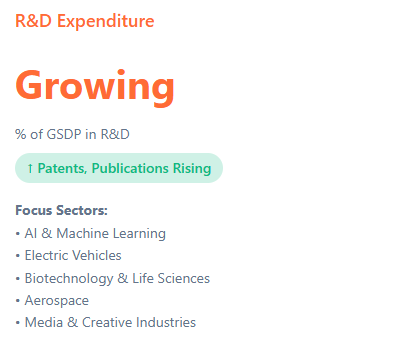
University–Industry Collaboration
Telangana is strengthening ties between universities and industry to accelerate its Vision 2047 goals. Academic institutions work directly with technology firms, manufacturing clusters, startups, and global partners to build a steady talent pipeline, expand applied research, and support commercial innovation. These partnerships help convert academic work into real-world solutions, improve sector-specific skills, and ensure that research output contributes to high-growth areas such as AI, life sciences, EV technologies, and aerospace manufacturing.
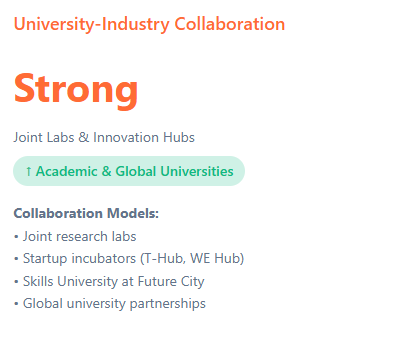
Telangana as the Innovation Capital of India
Telangana is shaping a long-term innovation blueprint that connects research, technology adoption, talent development, and global partnerships. With strong, substantial investments in leadership in AI, biotech, EV systems, aerospace, digital governance, and startup growth, the state positions itself as a national innovation leader. The AI Mission, Future City initiatives, expanding university–industry collaboration, and rising R&D output strengthen this transition. By 2047, Telangana aims to anchor India’s technology progress through advanced research hubs, deep-tech entrepreneurship, and sustained investment in high-skill sectors, establishing itself as the country’s primary engine for innovation-led growth.
Positioning Against Karnataka (Bengaluru)
Telangana strengthens its competitive advantage by building large planned zones such as Future City and AI City. These areas offer structured growth, reliable utilities, and integrated tech infrastructure. Businesses also benefit from lower operational costs compared to Bengaluru. Senior leadership engages global CEOs through targeted outreach, which shortens decision cycles and supports quick clearances. This combination helps firms operate with fewer delays and predictable expansion pathways.
Positioning Against Gujarat
Telangana has a strong, more substantial knowledge-driven sector, such as AI, life sciences, and IT. The state maintains a larger startup network, with higher founder activity and deeper technological capabilities, across early- and scale-stage companies. It also benefits from a denser talent pool and advanced digital systems. These conditions strengthen its suitability for high-skill research, product engineering, and deep-tech growth.
Positioning Against Maharashtra (Mumbai)
Telangana outperforms Maharashtra on ease of doing business and offers a more predictable environment for new investments. Improved urban planning, reduced congestion, and faster service delivery strengthen its appeal to technology and manufacturing firms. The state also invests in net-zero urban development models, giving it an advantage in sustainable infrastructure and next-generation city design.
Integrated Competitive Position
Across these comparisons, Telangana positions itself as the preferred innovation destination by combining planned growth, digital efficiency, strong talent supply, and advanced sectoral depth. This supports the state’s broad aspiration for the country to be a leader in technology, research, and sustainable urban development.
Telangana’s Strategic Innovation Strengths
Telangana builds its innovation strength through planned technology districts, a strong digital governance model, and deep collaboration between government, industry, and universities. The state advances high-skill sectors such as AI, life sciences, EV manufacturing, aerospace, and creative industries. Startup networks, research hubs, and global partnerships strengthen this momentum. These elements support the broader 2047 vision by expanding talent, accelerating research output, and positioning Telangana as a leading center for future technologies and knowledge-driven growth.
Manufacturing Backbone
Telangana strengthens its innovation goals with a growing manufacturing base supported by industrial corridors, dry ports, and measurable improvements in logistics. The state reports an 18 percent gain in increased efficiency, which improves chain reliability and reduces on-time delays. This foundation supports sectors such as electronics, aerospace, EV production, and pharmaceuticals, and it connects directly to export growth and future industrial clusters under the 2047 vision.
Innovation Ecosystem
The state’s innovation ecosystem continues to expand, anchored by more than 6,500 startups and the STR presence of T H networks, which at the STR Hub help entrepreneurs access capital, mentoring, and product testing opportunities. They also give global investors clear visibility into Telangana’s tech strengths. The ecosystem supports the state’s target to position itself as a major center of significance across AI, deep tech, health tech, mobility, and creative industries.
Knowledge Industries
Knowledge-driven sectors play a central role in Telangana’s economic structure. IT and related services contribute 19% of GSVA, underscoring Gate’s reliance on highly skilled talent and advanced service delivery. This concentration of knowledge industries strengthens research, digital governance tools, and emerging tech capabilities, which are central to the 2047 transformation model.
Infrastructure
Major infrastructure programs support long-term innovation and economic expansion. Metro rail extensions improve connectivity within core urban zones. The Future City plan creates a large integrated urban district designed for new-age industries, skills training, and clean transport. The Musi Riverfront project adds environmental and urban renewal value, creating a more sustainable and well-planned growth environment.
Policy Edge
The state uses a predictable policy environment with a focus on rapid decision-making and direct executive-level engagement. CEO-led partnerships help investors access the government without long wait times or unclear processes. The showcase model presents a clear, precise project design and investment opportunities to domestic and global partners. These elements improve investor trust and support the long-term transformation vision.
Fiscal Strength
Telangana’s fiscal profile remains strong, supported by 88 percent of its own tax revenue. This provides the state with financial independence to plan and implement innovation, infrastructure growth, and public programs. Higher own revenue also reduces reliance on external borrowing for core development priorities.
Net Zero Leadership
The state integrates clean energy and climate goals into its innovation agenda. Telangana targets 26,374 MW of solar capacity, develops hydrogen pilot projects, and maintains 33 percent forest cover. These investments support the state’s shift toward a low-carbon economy and align with global sustainability benchmarks. They also enhance the Future City and AI City projects by embedding clean power, efficient mobility, and green infrastructure into long-term planning.
This combination of strong manufacturing, expanding research ecosystems, planned urban development, and climate-focused infrastructure positions Telangana as a competitive, future-ready innovation center within the country’s 2047 transformation plan.
Tech Pulse, Emerging Opportunities for 2030–2047
Telangana enters the next phase of its transformation with a growing focus on future technologies that shape global competitiveness. The state’s strategy builds on AI City, Future City, advanced digital governance, R&D expansion, and strong university–industry collaboration. Between 2030 and 2047, significant opportunities will emerge across AI and automation, deep-tech research, clean mobility, quantum computing, health technology, and creative digital industries. Telangana’s expanding startup base, growing research output, and increasing global partnerships position it to lead in high-value innovation. The state’s focus on skills, urban planning, clean energy, and strong fiscal capacity supports a long-term technology-driven growth model aligned with the Telangana Rising 2047 vision.
Telangana’s long-term transformation strategy identifies several high-value technology domains that strengthen growth between 2030 and 2047. These areas combine global demand trends, local capabilities, and targeted state programs that support the broader Telangana Rising 2047 vision.
AI and Deep Tech
The 200-acre AI City creates a concentrated zone for advanced computing, research, and product development. It brings together global firms, startups, and research groups to build applications in generative AI, governance AI, health AI, and automation. The hub adds scale to the state’s existing digital economy and positions Telangana as a competitive center for deep-tech growth.
Climate Technology
Progress in green hydrogen, battery energy storage systems, and carbon capture introduces new clean-energy opportunities. These areas support the state’s net-zero commitments and provide a foundation for future manufacturing, energy innovation, and green-job creation.
Electric-Vehicle Ecosystem
Future City includes EV clusters that support component manufacturing, charging infrastructure, testing centers, and R&D. This integrated ecosystem expands domestic EV production capacity and strengthens the supply chain for batteries, motors, and software systems.
Biotechnology and Life Sciences
Genome Valley’s expansion allows more research, manufacturing, and testing in biotechnology and life sciences. The area attracts global firms in vaccines, bio-pharma, medical devices, and advanced therapeutics, reinforcing Telangana’s leadership in this sector.
Aerospace and Aviation
Growth in aviation, drone systems, and aerospace manufacturing opens new possibilities for high-precision engineering and defense-linked production. These activities support export-ready products and emerging mobility technologies.
Media and Creative Industries
Film-studio partnerships and digital production structures encourage innovation in animation, VFX, gaming, and virtual production. This sector benefits from rising global demand for content and cr, creatingportunities for skilled workers.
Quantum Computing
Joint labs and multi-university research networks strengthen quantum research in software, hardware, encryption, and simulation. This work prepares Telangana for next-generation computing breakthroughs and positions the state as an early participant in quantum innovation.
Green Jobs
Net-zero commitments across energy, mobility, construction, and manufacturing increase demand for a workforce skilled in clean technologies. The focus on green jobs supports long-term sustainability goals and broadens future employment opportunities.
These combined opportunities build a diversified and future-ready innovation framework. They reinforce Telangana’s long-term economic strategy, strengthen global competitiveness, and advance the direction outlined in Telangana Rising 2047.
Vision 2047, Innovation Target Tracker
The Innovation Target Tracker supports Telangana Rising 2047 by monitoring progress across onechnology, research, and industry development. It captures measurable shifts in AI adoption, R&D output, startup performance, infrastructure expansion, and global partnerships. The tracker helps you assess how quickly the state moves toward building a strong innovation economy, expanding advanced manufacturing, and scaling new sectors such as climate tech, life sciences, EVs, aerospace, and digital media. It ensures that long-term objectives remain visible, quantifiable, and aligned with the broader transfo2047 rmation strategy for the 20angana Global Summit 2025 and Signature Projects.
The Telangana Global Summit 2025 positions the state as a long-term investment destination and a central hub for technology, sustainability, and future-focused development. The event brings global companies, research leaders, and investors together to showcase the state’s strengths, including AI City, Future City, and large-scale climate and mobility projects. These signature initiatives highlight the government’s commitment to advanced infrastructure, digital-first governance, clean energy leadership, and innovation-driven economic growth. The summit serves as the anchor for Telangana Rising 2047, supporting investment, research collaboration, and a clear pathway for global partnerships.
Shift From Conventional Summits
Telangana is replacing the standard investor summit format with a model built on real project demonstrations, transparent execution plans, and sector-focused showcases. Instead of limiting the event to speeches and MoU sessions, the state presents working prototypes, early-stage infrastructure, and live technology deployments. This approach gives investors a clearer sense of what they can build, how soon they can start, and what support they will receive.
Immersive Experience-Based Engagement
The showcase model allows investors to interact directly with flagship projects such as AI City, Future City, EV clusters, net-zero pilots, and Musi Riverfront redevelopment. You see the progress, the teams behind the projects, and the operational frameworks in place. This structure reduces uncertainty and speeds up due diligence because the evidence is visible at the event itself.
Demonstration of Readiness
Government departments present execution roadmaps, timelines, and regulatory structures. Investors review zoning plans, land availability, financial models, and sector-specific incentives. This reduces the need for multiple follow-up meetings and shortens decision cycles.
Stronger Global Positioning
The model builds Telangana’s credibility by showing that projects are already under construction or ready for launch. Instead of competing with states that rely on large MoU numbers, Telangana focuses on proof-based engagement and measurable progress. This approach supports the broader Telangana Rising 2047 framework, which emphasizes innovation, sustainability, and implementation strength.
Event Details
The Telangana Global Summit uses a structure that highlights the state’s long-term transformation agenda rather than a conventional conference format. The event brings together global CEOs, technology leaders, researchers, and policymakers for sector-specific sessions tied directly to projects under Telangana Rising 2047. Each event component showcases real progress, such as live demonstrations from AI City, Future City, green mobility clusters, and net-zero pilots.
The program combines focused roundtables, project walkthroughs, and evidence-based presentations to show investors how projects are being built and the opportunities in the next decade. This format creates direct visibility into execution capacity, governance efficiency, and the innovation pipeline. It strengthens global confidence in Telangana’s transition toward an advanced knowledge economy and positions the summit as a practical platform for investment, technology partnerships, and future-ready development.
The Telangana Global Summit 2025 is scheduled for December 8 and 9, 2025, at Bharat Future City in Mucherla, Rangareddy. The venue spans 100 acres and serves as a live demonstration of the state’s next-generation development model. The summit will host 1,300 invited leaders from 500 major national and global companies.
Structure and Purpose
The movedymgovernment, which had moved from investor to the headrigovernment, designed the summit to give participants a direct view of Telangana’s infrastructure pipeline, execution capacity, and long-term vision under Telangana Rising 2047.
The program uses site experiences, project walkthroughs, sector demonstrations, and focused strategy sessions to show how the state is building Future City, AI City, green mobility infrastructure, climate tech clusters, and logistics corridors. This approach helps you assess real progress rather than theoretical plans.
Strategic Intent
The model positions Telangana as a state ready for decades of innovation-led growth. It shows strong governance, advanced planning, and high readiness for investment across technology, industry, and sustainable urban development. The summit is structured to build trust, demonstrate capability, and strengthen global partnerships for the next phase of Telangana’s transformation.
Why This Model Works
Telangana’s approach succeeds because it focuses on real evidence rather than symbolic events. The model gives investors direct access to completed infrastructure, future-ready project sites, and clear policy pathways. Senior industry leaders see how the state plans, executes, and scales complex initiatives such as AI City, Future City, climate tech clusters, and mobility corridors.
This transparency builds confidence, strengthens long-term partnerships, and positions the state as a credible destination for innovation-led investments under Telangana Rising 2047.
Direct CEO Engagement
CM Revanth Reddy’s outreach to more than one hundred global CEOs strengthens investor confidence. These meetings give senior leaders a clear view of Telangana’s long-term direction and its commitment to innovation-led development.
On-Ground Exposure to Strategic Projects
The model centers on direct on-site rather than in-person. Investors observe Future City, AI City, the Musi Riverfront redevelopment, and major industrial corridors in real time. This approach shows how the state plans projects, calls them, and allocates them to sectors.
Demonstration of Governance and Execution
Live demonstrations highlight how departments operate, coordinate, and deliver outcomes. This gives investors clear evidence of execution capability, administrative discipline, and readiness for large projects across mobility, technology, energy, and infrastructure.
Integration of Cultural Diplomacy
The event design includes elements combining technology, such as shows and a Guinness World Record attempt. These features strengthen public engagement and introduce visiting leaders to the state’s cultural identity while maintaining focus on progress and innovation.
Public-Facing Engagement After the Summit
A large public expo follows the summit. It includes food courts, cultural shows, and carnival zones. This extension encourages community participation, showcases local talent, and increases public visibility of the government’s development agenda.
Strategic Advantage
The model works because it shifts investor engagement from theoretical presentations to tangible proof. Leaders observe infrastructure, project planning, and execution quality without filters. This builds stronger trust, positions Telangana as a reliable growth partner, and supports the objective Rising 2047.
Thematic Anchors of Summit 2025
The Summit 2025 themes reflect Telangana’s long-term direction under the Telangana Rising 2047 framework. They highlight the state’s transition toward innovation-led growth, sustainable infrastructure, and global competitiveness. Each theme connects directly to Future City, AI City, green mobility, and digital governance programs already in progress. The anchors focus on advanced technology adoption, climate action, clean energy, inclusive development, and next-generation urban planning. Together, they frame Telangana as a high-capacity, future-ready state that combines strong governance, modern infrastructure, and a clear economic vision for 2047.
3T Vision, Pathway to a ₹3 Trillion Economy
The summit places the 3T framework at the center of Telangana’s long-term economic direction. It presents a clear roadmap for scaling growth through technology, trade, and tourism. The anchor highlights how sustained reforms, targeted investments, and advanced sector development contribute to the 2047 economic target.
Infrastructure Excellence
This anchor focuses on large-scale public infrastructure that demonstrates design quality and operational readiness. Future City, Metro Phase II B, and the Musi Riverfront show how the state is reshaping mobility, urban form, and environmental assets. These projects serve as evidence of the state’s execution strength and long-term planning.
Spatial Planning Framework
The Telangana Core Urban Region blueprint introduces coordinated regional planning that integrates transport, industry, housing, and environmental zones. This anchor signals a structured approach to urbanization, with growth occurring in planned corridors supported by multimodal networks.
Inclusive Development
This theme highlights the Women, Farmer, Youth Empowerment Model, which creates direct pathways for economic mobility. It demonstrates the state’s intention to combine technological progress with social equity so that every demographic group benefits from the opportunities created by City, AI City, and sectoral expansion.
Net Zero Telangana
This anchor brings together clean energy expansion, green hydrogen pilots, and forest zone development. It signals a commitment to long-term climate responsibility, supported by renewable capacity additions, restoration, and carbon-reduction initiatives. It positions Telangana as a future-focused state with integrated economic and environmental planning.
Expected MoUs and Signature Projects
The summit is set to generate high-impact partnerships that reinforce Telangana’s long-term transformation agenda. Expected MoUs focus on strategic sectors such as AI, clean energy, mobility, life sciences, and advanced manufacturing. These agreements are designed to strengthen the state’s innovation capacity, expand global collaborations, and accelerate capital inflows. Signature projects tied to Future City, AI City, and next-generation industrial corridors highlight the state’s ability to convert commitments into actionable development. Each project supports the broader Vision 2047 approach, where investment, technology adoption, and inclusive growth move in a unified direction.
Sports City Projects, Multi-Sport Infrastructure Hub
Sports City strengthens Telangana’s push toward a future-ready urban and economic ecosystem by creating a dedicated hub for national and international sporting activity. The project integrates training facilities, stadium clusters, athlete development centers, and public recreation zones. It supports talent pipelines, professional leagues, and sports tourism, while aligning with the state’s broader 2047 goals for health, youth engagement, and global competitiveness. As part of the wider Future City and regional planning framework, Sports City demonstrates how large-scale infrastructure can contribute to economic diversification and long-term human capital development.

Ajay Devgn & Salman Khan Film Studios, Mega Media Infrastructure
Telangana Rising 2047 positions large-scale film studio investments as a core part of its creative economy strategy. The proposed Ajay Devgn and Salman Khan Film Studios strengthen this plan by adding modern production facilities that support cinema, OTT, and digital media. These studios serve as advanced media clusters within Future City and expand the state’s ability to attract national and international productions. The project boosts creative jobs, accelerates content exports, and supports Telangana’s aim to build a competitive media and entertainment hub by 2047.
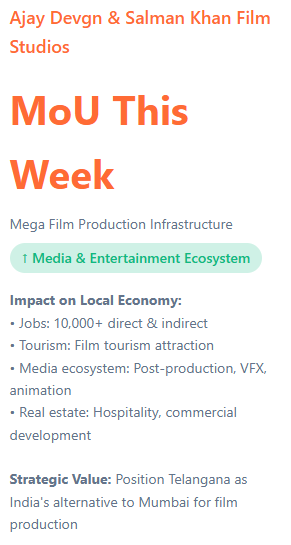
Tourism Development Partnerships
Tourism development partnerships under Telangana Rising 2047 focus on expanding high-value tourism zones, building global-standard attractions, and integrating tourism with the state’s economic and cultural strategy. The state promotes collaborations with private developers, hospitality groups, and international brands to upgrade infrastructure, enhance visitor experiences, and connect tourism growth with job creation. These partnerships support heritage restoration, nature-based tourism, urban entertainment districts, and experience-led destinations, all of which contribute to a stronger tourism economy within the broader transformation framework.

HMDA Infrastructure Projects – Future City and Urban Development
Telangana is using HMDA’s expanded mandate to build a unified urban development model that supports long-term development. Future City, the core of this model, integratesringstructurall designstructuralng with smartmobilityt,commercia l developmentClientt climate-resilient designi.Client design Phase II, arterial road upgrades, and new logistics corridors strengthen regional connectivity, while the Musi Riverfront restoration transforms urban public space and environmental quality. These projects anchor Telangana’s 2047 vision by creating a well-planned, high-productivity region that supports industry, innovation, and inclusive growth.
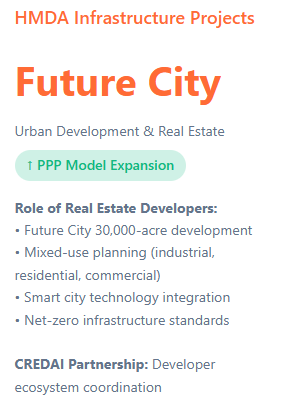
Participant Categories and Ecosystem Partners
Telangana Global Summit 2025 brings together a structured mix of stakeholders who shape the state’s economic and innovation agenda. The participant group includes global CEOs, industry leaders, venture capital firms, policy makers, urban planners, technology partners, and domain experts from priority sectors. These participants engage directly with the state’s long-term review project pipelines, and assess Telangana’s readiness for large-scale.
The summit also integrates ecosystem partners who support the 2047 transformation agenda. These include global consulting firms, industry bodies, trade associations, academic collaborators, research networks, development banks, and multilaterals. Their presence connects Future City, AI City, and related signature projects to technical standards, funding models, and global best practices. This mix strengthens the state’s outreach and reinforces Telangana’s positioning as a high-capability, innovation-driven state.
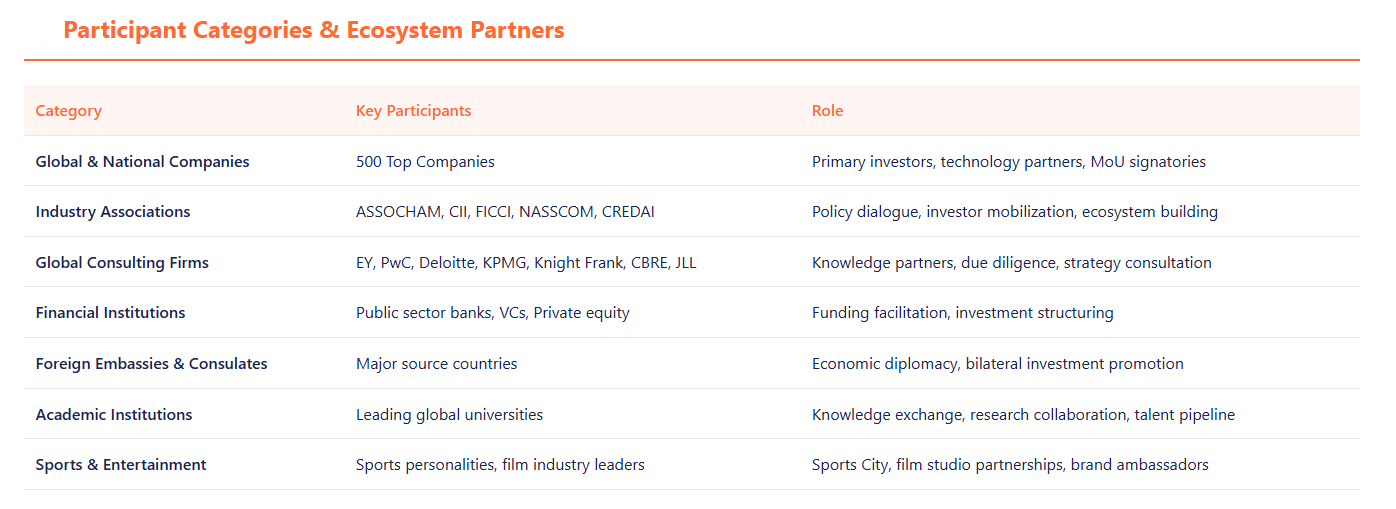
Cultural Diplomacy and Public Engagement
Cultural diplomacy and public engagement form a part of Toana’s approach to investor outreach and global positioning under the Vision 2047 transformation agenda. The model connects technology, infrastructure, and economic ambition with Telangana’s social identity and cultural strengths, creating a balanced narrative that appeals to both global leaders and citizens.
The state uses cultural elements such as live performances, curated showcases, and regional storytelling to present Telangana as confident, modern, and rooted in heritage. These elements support government efforts to build trust with global CEOs and investors by offering an authentic experience rather than a transactional summit format. Public engagement expands after the summit with open exhibitions, food zones, cultural shows, and heritage displays designed for citizens. This ensures that large significant contributions to social participation, tourism, and state branding, while reinforcing the government’s message that economic growth and cultural identity advance together.

20 Flagship Showcase Projects for Summit 2025
Telangana is preparing a focused set of flagship projects that demonstrate its long-term direction under Vision 2047. These projects highlight strengths across technology, infrastructure, sustainability, manufacturing, culture, and global partnerships. Each initiative has been selected to demonstrate execution capability and investment readiness; together, they form a unified showcase of Future City planning, advanced mobility, renewable energy, innovation clusters, industrial expansion, cultural assets, and high-growth sectors. The portfolio strengthens Telangana’s position as a rising national leader in technology-driven development and reflects the state’s ambition to build a modern, inclusive, and globally competitive economy.
Mega Urban Projects
Bharat Future City, 30,000 Acres
Bharat Future City represents Telangana’s largest and most significant urban expansion. The project combines residential, industrial, and commercial development at scale and serves as the anchor of long-term planning. It supports advanced manufacturing, digital services, and clean energy systems. The state positions this zone as the center of Future City innovation for 2047.
Musi Riverfront Development, 55 km
The Musi revitalization program covers riverfront restoration, mobility corridors, flood management, tourism areas, and public recreation. The state plans to convert the 55 km stretch into a modern urban asset that supports economic activity and improves quality of life.
AI City, 200 Acres
The AI City zone brings research centers, AI product labs, data infrastructure, and deep tech into a single cluster. The state aims to create one of India’s strongest AI ecosystems and connect it to global partners.
Infrastructure Excellence
Metro Phase II B, 86.1 km, ₹19,579 crore
This expansion increases high-capacity across Hyderabad. It improves commute times, reduces congestion, and connects major residential and commercial hubs. The project supports the broader Future City development plan.
Industrial Corridors and Dry Ports
Telangana strengthens industrial logistics by expanding dry ports and industrial corridors. These additions improve freight movement and reduce logistics costs. Manufacturing, electronics, and food processing businesses gain faster access to markets.
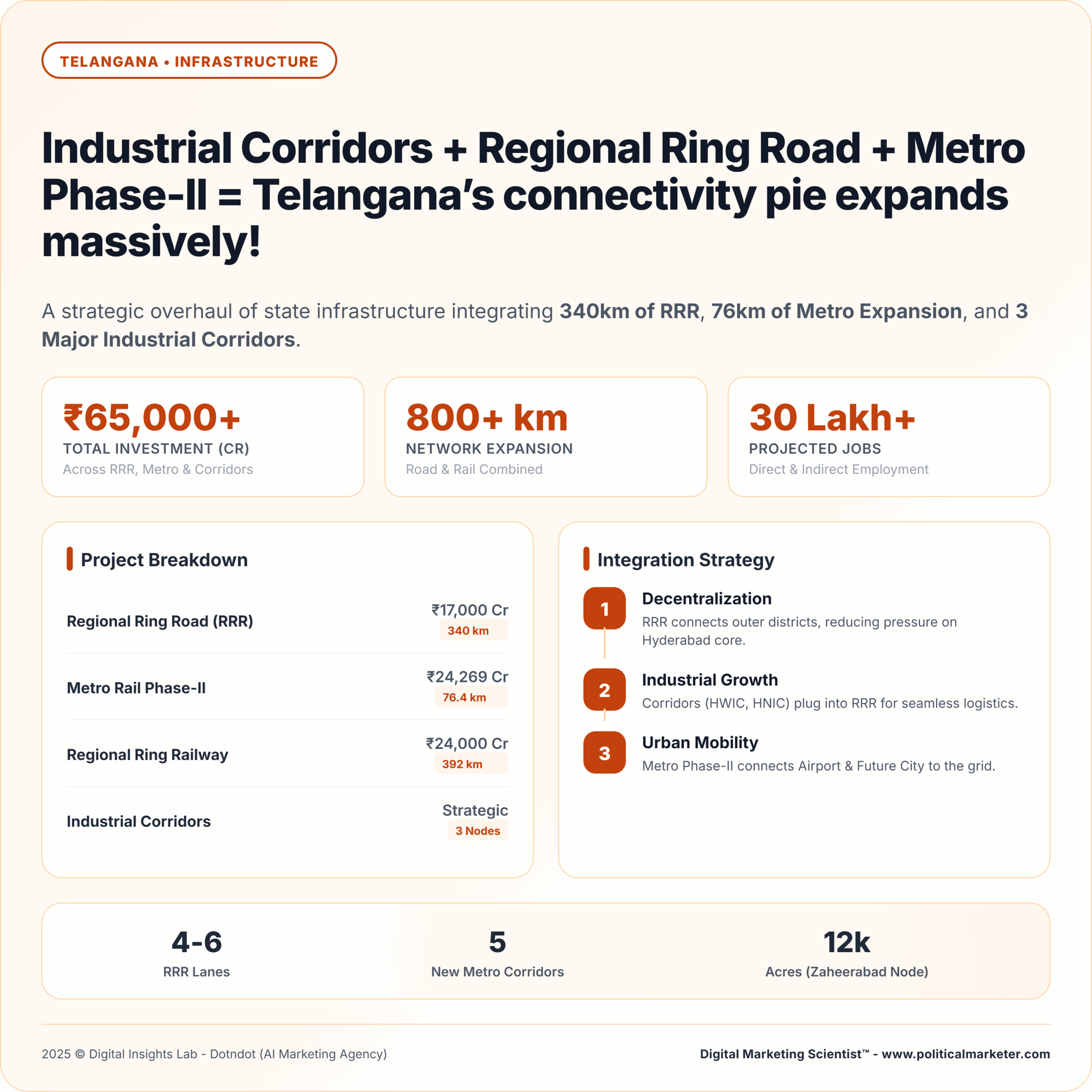
Logistics Parks, +18 percent Efficiency
New logistics parks improve storage, transport integration, and supply chain predictability. The plan includes multimodal hubs that support the state’s ambition to achieve an 18 percent improvement in logistics efficiency.
Innovation and Technology
AI Innovation Hub, Global Top 20 Goal
The AI Innovation Hub strengthens Telangana’s position in advanced research and product development. The state aims to rank the top 20 AI hubs. The Hub encourages collaboration between startups, large companies, and research centers.
T Hub, 2,000+ Startups Incubated.
T Hub continues as a key driver of startup growth. With more than 2,000 incubated companies, it supports founders in sectors such as AI, mobility, digital health, and enterprise software. The Hub contributes to job creation and innovation density.
WE Hub, Women Entrepreneurship
WE Hub supports women-led startups by offering programs in product development, capital access, and capacity building. The model strengthens women’s participation in high-potential sectors across the state.
Green Energy and Sustainability
26,374 MW Solar Target
Telangana’s solar expansion plan raises capacity to 26,374 MW. This supports industrial power needs, clean energy goals, and grid stability. The target connects to the broader 2047 clean energy pathway.
Green Hydrogen Pilot
The state introduces a green hydrogen pilot to test use cases in mobility, industrial processing, and storage. The pilot adds a strategic clean energy option for the long term.
Net Zero Future City Zone
Part of Bharat Future City will operate on net-zero emissions, powered by efficient, clean energy sources and sustainable mobility systems.
Entertainment and Sports
Sports City
Sports City focuses on multi-disciplinary centers, stadiums, academies, and youth development programs. It strengthens Telangana’s sports ecosystem and supports event hosting.
Film Studios, Ajay Devgn, and Salman Khan
New film studio investments by leading actors introduce production, post-production, and FX facilities in Telangana, offering an alternative to Mumbai for film production.
Tourism Development MoUs
Tourism agreements include eco tourism, heritage circuit upgrades, and hospitality expansion. These partnerships strengthen the state’s visitor economy.
Social and Human Development
Skills University, AI, EV, Green Tech
The Skills University focuses on advanced domains such as artificial intelligence, electric mobility, and green technologies. It builds a talent pipeline that meets industry needs.
Women, Farmer, Youth Club
This statewide platform supports livelihoods through training, market access, digital programs, and community development.
Rajiv Aarogyasri, ₹10 Lakh Health Coverage
The revised Aarogyasri model offers up to ₹10 lakh coverage for families. The program improves health security and reduces out-of-pocket spending.
Economic Growth Drivers
Startup Ecosystem, 6,500+ Startups, and 40 to 50 Unicorns Goal
Telangana’s startup network has grown to more than 6,500 startups. The state sets a long-term goal of reaching forty to fifty unicorns. This target requires stronger access, more profound technical expertise, and global market entry.
Strategic Positioning
The state positions its economy on three pillars: manufacturing, innovation, and knowledge industries. These sectors form the foundation of Telangana’s 2047 growth model and support steady job creation and investment.

Vision Document Unveiling, $1T by 2035 and $3T by 2047
The state’s new vision framework sets a clear growth path toward a one-trillion-dollar economy by 2035 and a three-trillion-dollar economy by 2047. The document outlines the core drivers of this long-term, including Future City development, clean energy expansion, advanced manufacturing, startup growth, and AI-led innovation. It presents a coordinated strategy that links infrastructure, talent development, technology clusters, and public welfare. The overall assessment of the plan remains positive, supported by current investment interest, global partnerships, and institutional readiness to execute at scale.
Vision Milestones
The vision document sets two clear economic targets for the state. You aim to reach a one trillion dollar economy by 2035, followed by a three trillion dollar economy by 2047. These milestones serve as a framework for long-term planning across departments and guide the state’s prioritization of structural, technological, industry-cluster, and social development.
Core Strategy
The growth plan rests on multi-sector expansion supported by twenty flagship projects. These include Future City, Musi Riverfront, AI City, renewable energy programs, large-scale construction, urban development, logistics upgrades, and skill-based capital building. The strategy uses these projects to drive investment, create new economic hubs, and build long-term competitiveness.
Administrative View
The Chief Secretary described the targets as achievable when departments work in a coordinated manner. This view highlights the administrative commitment behind the plan and reflects the current momentum in project preparation, investor activity, and state-level reforms.
Overall Assessment
The outlook stays positive because the state has already begun laying the foundations needed to meet the milestones. Current investor participation, strong sector pipelines, global partnerships, and the state’s preparedness to execute large programs strengthen the credibility of the long-term transactions. The document presents a unified roadmap that combines economic growth, innovation, and inclusive development under the Telangana Rising 2047 framework.
Why Global Investors Are Confident
Global investors show steady confidence in the state’s clear long-term roadmap and measurable goals under the Telangana Rising 2047 program. The government has outlined sector-specific projects, a coordinated administrative structure, and a predictable policy environment. Large-scale initiatives such as Future City, AI City, renewable energy programs, logistics parks, and metro expansion signal strong project readiness and clarity of investment.
Investors also respond to the state’s commitment to transparent processes, faster approvals, and structured partnerships. The presence of global companies, consulting firms, financial institutions, and academic partners in the summit ecosystem reinforces trust. With defined economic targets, proven execution capacity, and the integration of innovation and sustainability into the growth plan, global investors view Telangana as a stable, future-focused investment destination.
Strong Economic Performance
You see steady investor confidence because the state posts consistent economic growth. Telangana recorded 10 percent GSDP growth in FY 24–25, placing it third among major central states. This performance signals stability, scalability, and a supportive economic environment. Growth at this level gives investors clear evidence of demand expansion, productive sectors, and reliable public finances.
Large Scale Infrastructure Commitments
Investors respond to the state’s extended long-horizon structure plan. Future City, AI City, industrial corridors, logistics parks, and urban transit expansion form a combined ecosystem that supports manufacturing, technology, and services. These projects reduce operational friction, shorten supply chains, improve logistics performance, and open new investment zones. Clear zoning, planned mixed-use and unmixed-use development, and prepared land banks lower the risks that investors often face in other markets.
Predictable and High Autonomy Governance
The state finances a large share of its expenditure with its own tax revenue, with a percentage of its spending coming from internal sources. This gives Telangana high autonomy in designing and executing development projects. Investors read this as a sign of predictable governance and faster decision-making. A higher internal revenue share also signals a broad tax base and productive economic activity.
Innovation Capacity and AI Leadership
The state’s AI Mission, startup programs, and accelerators position it as a hub of innovation. Telangana ranks fourth in India in startup activity. You also find a growing number of AI, deep tech, and enterprise technology ventures linked to T Hub, WE Hub, and related platforms. This concentration of talent and early-stage activity makes the state attractive to global companies seeking product engineering capabilities, research partnerships, and market-ready solutions.
Long-Term Sustainability Commitments
Investors in manufacturing, mobility, technology, and infrastructure now factor climate commitments into their investment decisions. Telangana sets clear targets, including 26,374 MW of solar capacity, a net zero roadmap, and green hydrogen pilots. These commitments reduce prolonged long-term uncertainty for large enterprises that plan to be low-carbon. Clear environmental goals also attract global funds that prefer jurisdictions with measurable climate action.
Combined Impact
Economic performance, infrastructure readiness, strong governance, and the depth of innovation and sustainability commitments work together to provide investors with a clear and stable outlook. This improves investor confidence and supports the state’s targets under the Telangana Rising 2047 framework.
Conclusion
The combined analysis shows that Telangana presents a clear, structured, and measurable development path that global investors and national stakeholders recognize as credible. The Telangana Rising 2047 framework links economic growth, infrastructure expansion, innovation leadership, and sustainability into a single long-term agenda supported by data, project pipelines, and institutional coordination.
Across all sections, the state demonstrates five consistent strengths:
A stable, high-growth economy backed by strong internal revenue generation.
Large-scale urban and industrial projects that prepare land, logistics, and connectivity for future investment.
A maturing innovation ecosystem supported by AI missions, startup accelerators, and university partnerships.
A clear sustainability roadmap with solar expansion, net zero strategies, and green hydrogen pilots.
A governance model focused on coordination, delivery, and predictable execution.
The Summit 2025 design reinforces this vision by linking investment promotion, public engagement, cultural diplomacy, and global partnerships with sector-specific showcases and MoUs. Every project, from Future City and AI City to Sports City and film production hubs, fits into a larger strategy of building a diversified economy that integrates technology, manufacturing, services, tourism, and creative industries.
Overall, the responses point to a state preparing for rapid acceleration. Through clear milestones, project-backed commitments, and a strong talent base, Telangana positions itself for sustained growth, broader engagement, and long-term economic transformation through 2035 and 2047.
Telangana Rising 2047: FAQs
What Is the Core Objective of Telangana Rising 2047?
The objective is to position Telangana as a $3 trillion economy by 2047 by expanding innovation, infrastructure, manufacturing, services, sustainability, and human development.
Why Are Global Investors Confident About Telangana?
They see consistent GSDP growth, strong, substantial autonomy, large infrastructure projects, a strong AI and startup ecosystem, and clear net zernet-zeroments.
What Are the Major Showcase Projects for Summit 2025?
Key projects include Bharat Future City, AI City, Metro Phase II-B, Musi Riverfront, Sports City, film studios, Skills University, renewable energy expansion, and green hydrogen pilots.
What Role Does Future City Play in the State’s Long-Term Strategy?
Future City serves as a multi-use urban hub with industrial, residential, and commercial zones built to smart city and net-zero standards across 30,000 acres.
How Is AI City Included in the Transformation Plan?
AI City aims to build a global AI innovation cluster with research hubs, data centers, training centers, and enterprise partnerships.
What Is the Purpose of the Musi Riverfront Project?
It focuses on ecological restoration, public spaces, mobility integration, and urban renewal along a 55 km stretch.
How Does the State Plan to Scale Renewable Energy?
The plan includes a 26,374 MW solar capacity target, a green hydrogen pilot, and a net zernet-zerodesign model.
What Economic Sectors Will Drive the $3 Trillion Target?
Manufacturing, clean energy, IT, AI-driven services, logistics, tourism, creative industries, and advanced skills development.
What Is Expected From the Sports City Initiative?
Sports City will include international-standard stadiums, training centers, youth programs, and global event hosting to generate jobs and raise tourism.
How Do Film Studios From Ajofofevgn and Salman Khan Contribute to Growth?
They support film production, VFX, animation, tourism, hospitality, and real estate, turning Telangana into a central hub for filmmaking.
What Partnerships Strengthen Tourism Development?
Work includes heritage restoration, digital tourism guides, eco-tourism across protected zones, and food and cultural exhibitions.
What Is the Purpose of the Drone Show and Guinness World Record Attempt?
It aims to amplify global media attention, showcase development milestones, and create visual storytelling for international audiences.
What Is Planned for the Post-Summit Public Expo?
The expo will feature cultural shows, Telangana food courts, carnival zones, and citizen access to Future City presentations.
How Will Security Be Managed During Summit 2025?
A high-security plan covers 1,300 VIP invitees, foreign delegations, and direct support by the Chief Secretary.
What Types of Participants Are Expected at the Summit?
Global companies, national firms, consulting agencies, industry bodies, financial institutions, embassies, universities, sports leaders, and entertainment industry representatives.
How Do Industry Bodies Support the Summit?
Bodies like ASSOCHAM, CII, FICCI, NASSCOM, and CREDAI contribute through policy dialogue, sector expertise, and ecosystem coordination.
What Is the Role of Academic Partners?
Institutions like IIT Hyderabad, BITS, and ISB contribute research, talent development, innovation programs, and joint projects.
How Does the State Plan to Sustain Long-Term Investor Confidence?
By maintaining predictable governance, clear project pipelines, strong revenue independence, innovation-led growth, and long-term sustainability targets.

